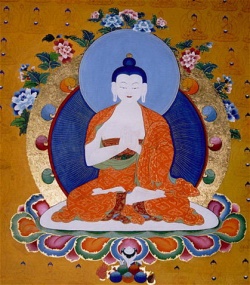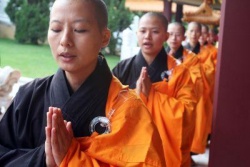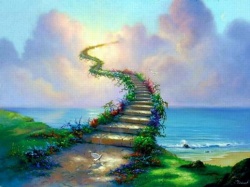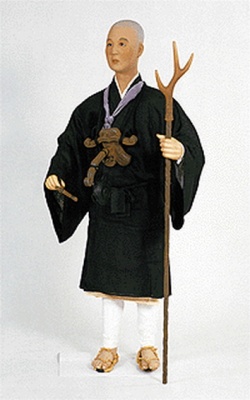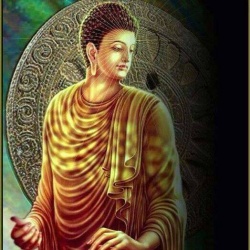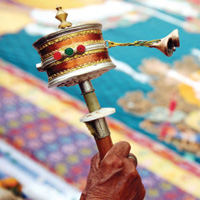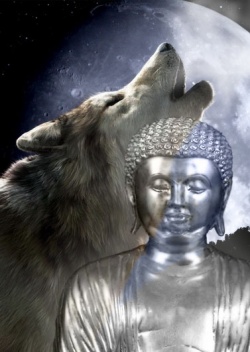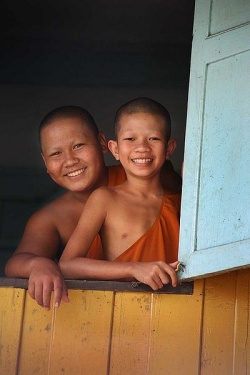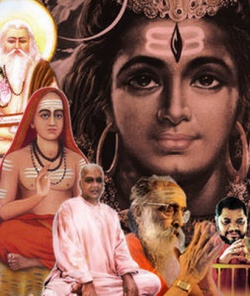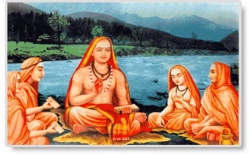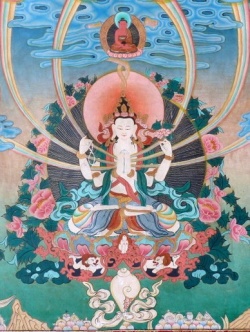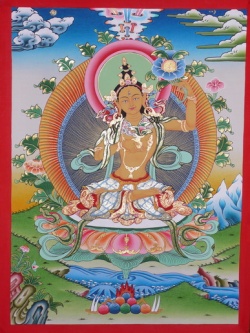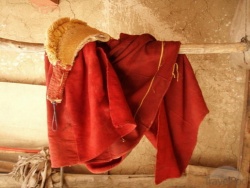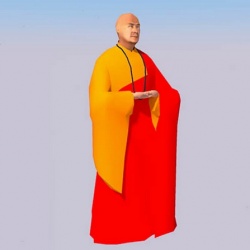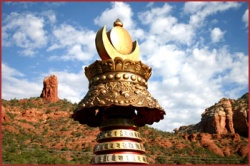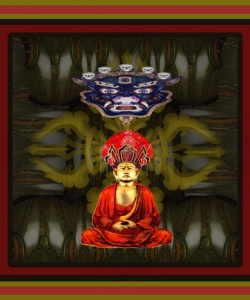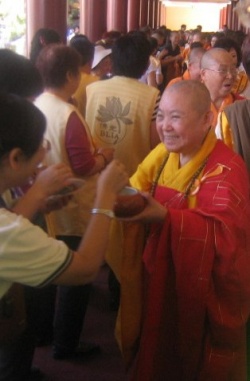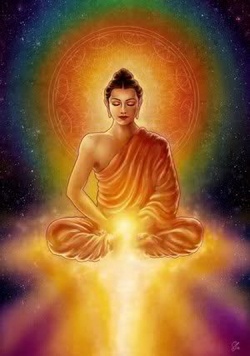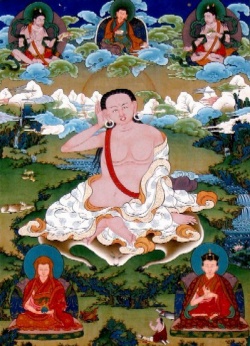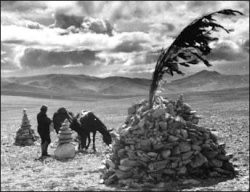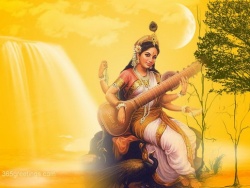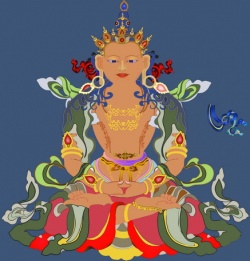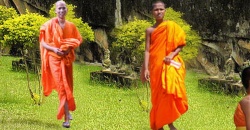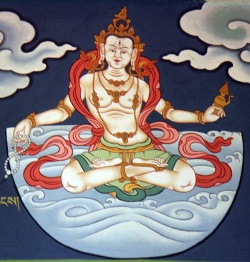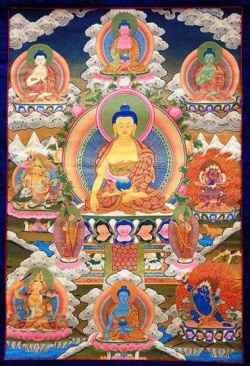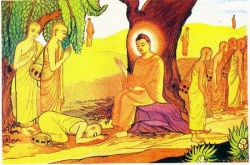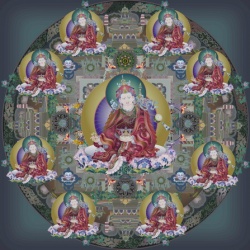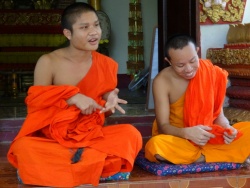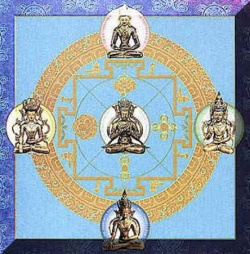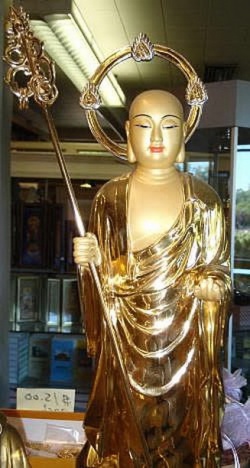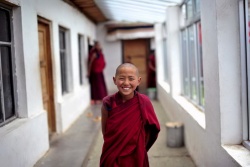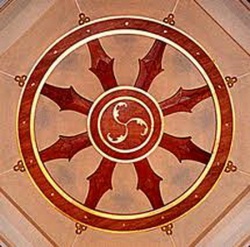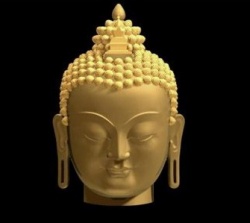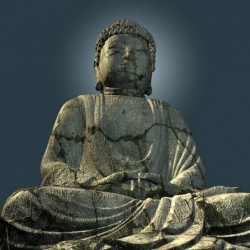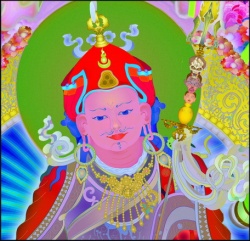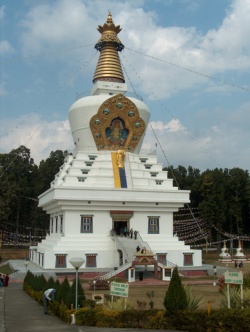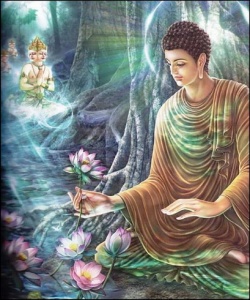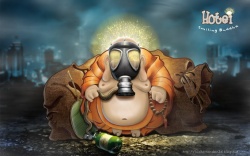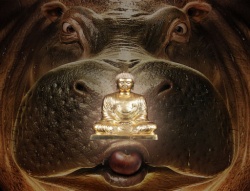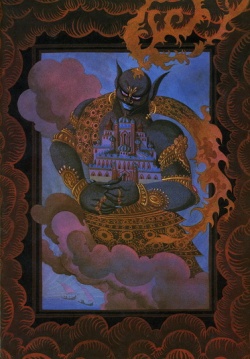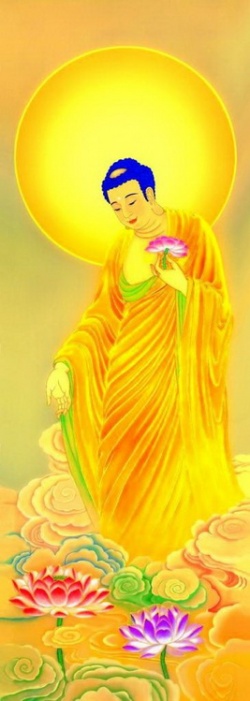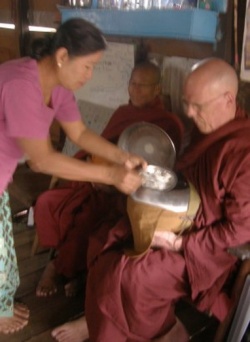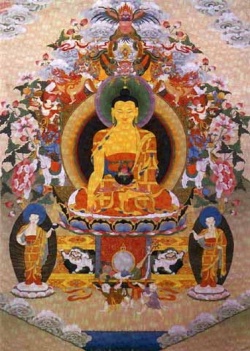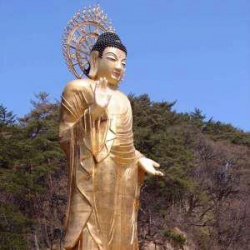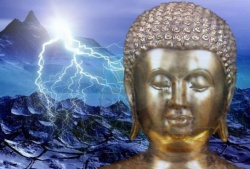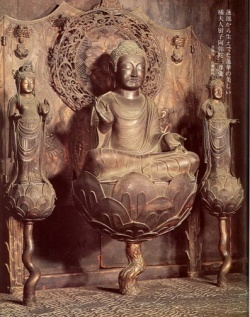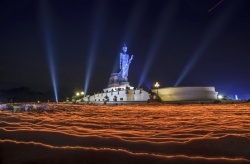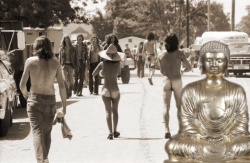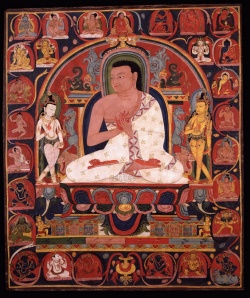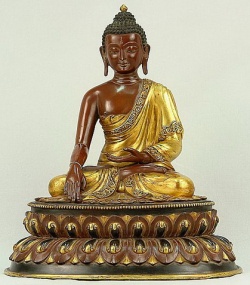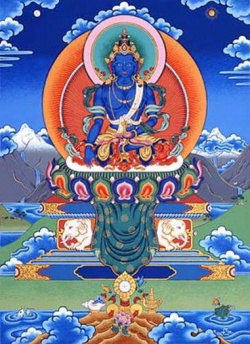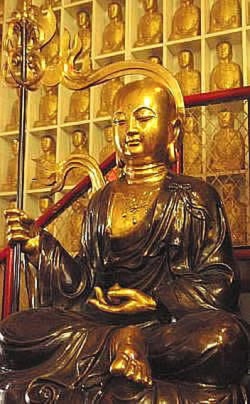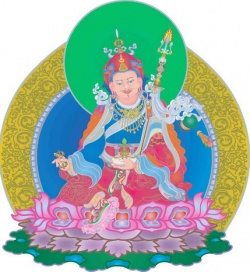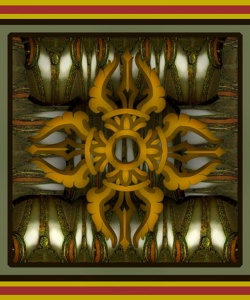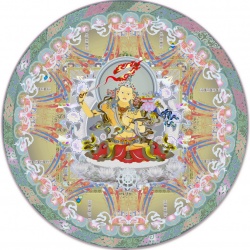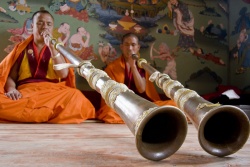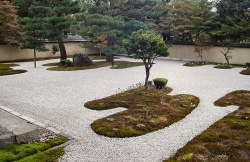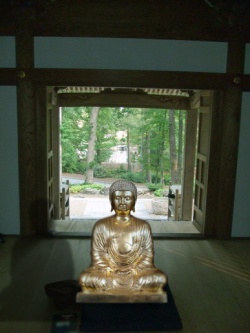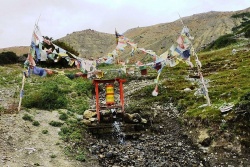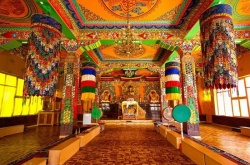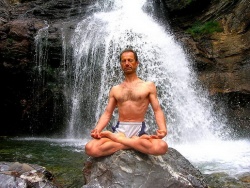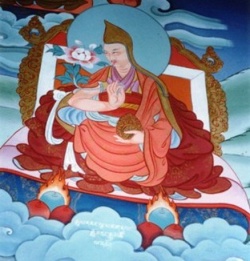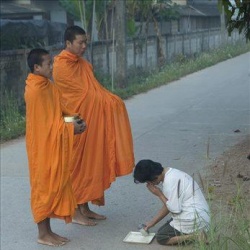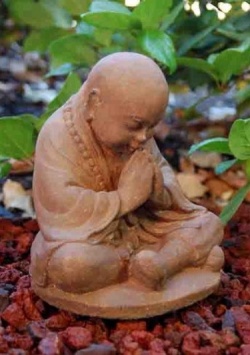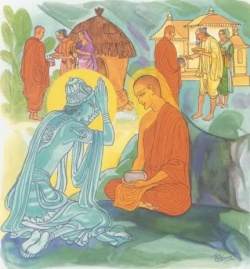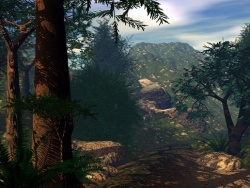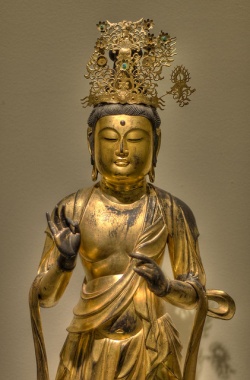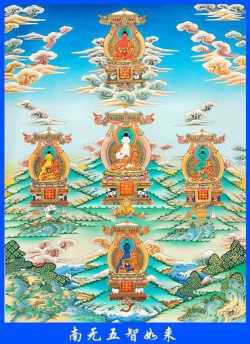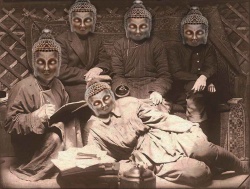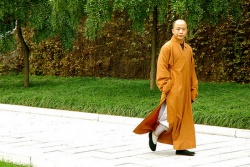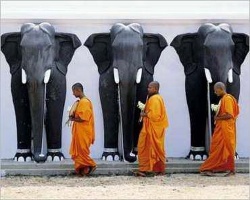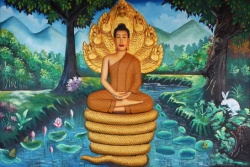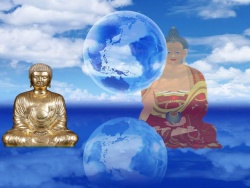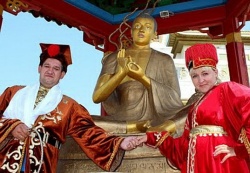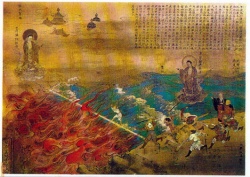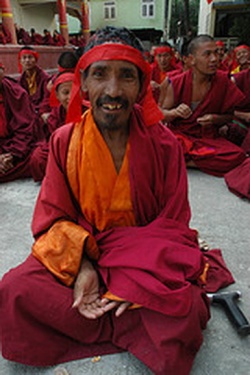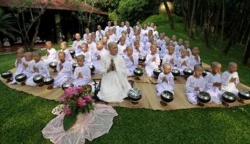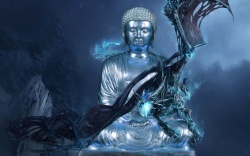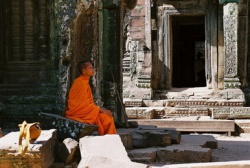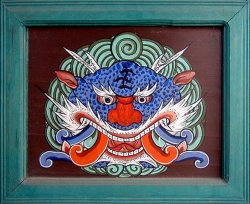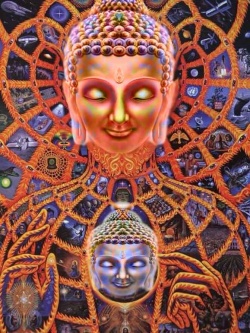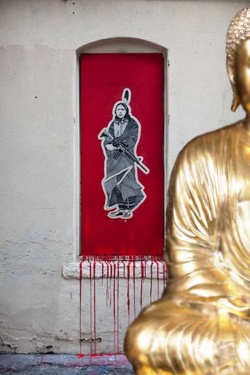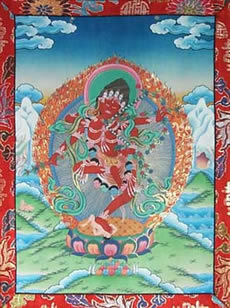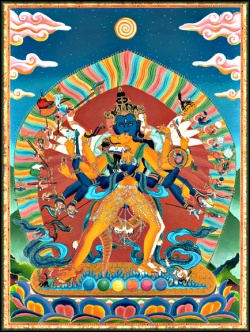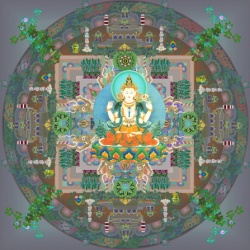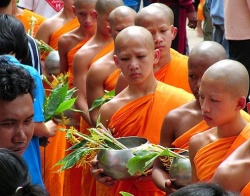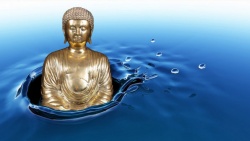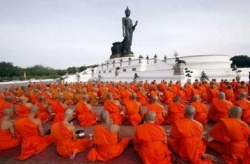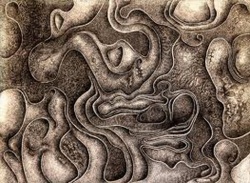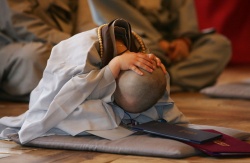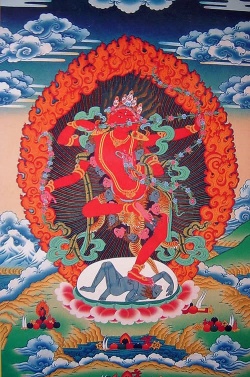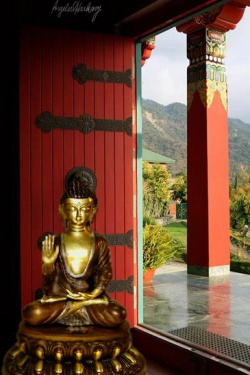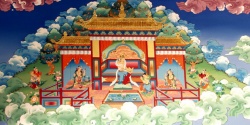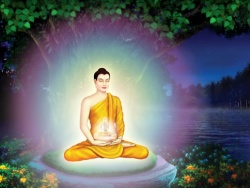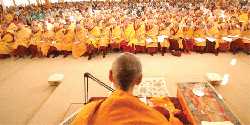The Wonderful Dharma Lotus Flower Sutra with commentary by the Venerable Master Hsuan Hua: Chapter 11: Vision of the Jeweled Stupa
The Wonderful Dharma Lotus Flower Sutra
with commentary by the Venerable Master Hsuan Hua
Chapter 11: Vision of the Jeweled Stupa
This is the eleventh of twenty-eight chapters of The Wonderful Dharma Lotus Flower Sutra, the Vision of the Jeweled Stupa. Stupa is a sanskrit word. It means “square grave”. It is a place where the relics of Buddhas and patriarchs are kept so that people can make offerings to them. They are also places where the Buddhas’ sharira are kept. The Jeweled Stupa in this Chapter was built by living beings for the Buddha Many Jewels after that Buddha went to Nirvana. Before he became a Buddha, the Buddha Many Jewels made a vow saying, “In the future wherever a Buddha manifests in any world and speaks The Dharma Flower Sutra, my jeweled Stupa will rise out of the earth in front of the assembly. It will appear in space so that all in the Dharma assembly can see it. When they see it, it will prove that the realm of The Dharma Flower Sutra is inconceivable.” He made the vow that whenever any Buddha spoke the Sutra he would do this.
Now, Shakyamuni Buddha is lecturing on The Dharma Flower Sutra and so the Thus Come One Many Jewels, based on his vow power, manifests in empty space. This should make us understand how important The Dharma Flower Sutra is. Therefore, the Buddha spoke it at the very end of his teaching career. First he spoke The Avatamsaka Sutra. Then he spoke the Agamas and The Vaipulya Sutras. Then he spoke Prajna. He waited until the very end to speak The Dharma Flower and Nirvana Sutras.
Now in America, first we lectured on The Shurangama Sutra. Last year during the summer session we spoke the Chapter of the Conduct and Vows of Universal Worthy Bodhisattva from The Avatamsaka Sutra and also The Sixth Patriarch Sutra. This year we are going to lecture this chapter of The Dharma Flower Sutra during the summer session.
We are gathered here in this lecture hall to investigate the Buddhadharma together. This is not a small causal condition. It is a great one. However, since you have not gained the Penetration of Past Lives or the Heavenly Eye, you will not understand the causes and conditions. Now that you have the opportunity to listen to this chapter of The Dharma Flower Sutra, that is an inconceivable state manifesting.
Most people see with their eyes. We see the Jeweled Stupa not only with the eyes, also with the mind. Not only do we see it with the mind, we see it with the original nature. This is because the Thus Come One Many Jewels is within the original nature of each one of us. The Stupa manifests from the Original Nature as the Thus Come One. Our vision of it is a vision of the Original Nature’s Thus Come One. This is how we see the Jeweled Stupa. It is not like any jeweled Stupas we have ever seen. It is really big and high!
I just said that the mind and the nature see the Jeweled Stupa and some people might not believe this principle. This principle, however, is completely true. Most people just know what they see with their eyes. They do not know that, basically, the eyes do not do the seeing at all. If the seeing were in the eyes, then when people were dead, and their eyes were still there, they should still be able to see things! Why people cannot see then? That proves that it is not the eyes that see. It is the mind.
“This is the scientific age. It is possible to take the eyes from one person and transplant them in another person’s body so that the second person can see,” you say. Yes, but in that case it is still not the eyes that see. The seeing is done by the seeing nature. Without the seeing nature, one cannot see.
“Well, then, what does the seeing nature look like?” you ask.
You cannot see it! So The Shurangama Sutra says, “When your seeing sees the seeing (nature), this seeing is no (longer) seeing. Your seeing (nature) is beyond your seeing, and your seeing cannot reach it.”
“If I cannot see it, then it does not exist!” you say.
If you want to reason that way, then the things you do see do not exist either!
You say, “I do not believe it.”
It is just because you do not believe it that you do not understand the doctrines contained in The Dharma Flower Sutra.
The Dharma Flower Sutra is for the purpose of breaking all your attachments. The material objects you see belong to the “marks division” of the Eighth Consciousness. In reality, they do not exist. That which you cannot see is real.
“But if it is real, I should be able to see it,” you say.
It is just because you are off by that much. Basically, you can see it. Your self-nature is filled with shining light, interpenetrating without obstruction. But you mistake the false for the true and so you cannot see the true. If you put down the false, then the true will manifest. That is the real you. The Shurangama Sutra investigates the question of “seeing” in great detail. Ananda cannot keep up with the Buddha’s arguments, either.
We should leave all our attachments. That which you cannot see is your true seeing. That which you can see is a manifestation of the “marks division” of your Eighth Consciousness. The more you investigate these principles, the more wonderful they get. The Vajra Sutra says, “All that which has marks is empty and false. If you can see all marks as no marks, then you can see the Thus Come One.” Can you see all marks as no marks? That means putting down the false so that the true manifests. Everything with shape and marks is false. If you see these false marks as untrue and false, then you see the Buddha.
So we will take the discussion of “seeing” the Jeweled Stupa and see it this far.
Sutra:
At that time, there manifested before the Buddha, a Stupa made of the seven jewels. It was five hundred yojanas in height and two hundred and fifty yojanas in breadth. It welled up out of the earth and stood in empty space, adorned with all kinds of jeweled objects. It had five thousand railings and thousands of myriads of alcoves. Countless banners and pennants adorned it as well. Jeweled beads were hung from it and myriads of millions of jeweled bells were suspended from its top. The scent of Tamalapatracandana issued from all four sides and filled the entire world. All its banners and canopies were made of the seven jewels: gold, silver, lapis lazuli, mother of pearl, carnelian, pearls and agate reaching up to the palace of the four heavenly kings.
Outline:
D2. Vision of the Jeweled Stupa: Chapter 11
E1. Prose.
F1. Many Jewels manifests.
G1. The manifesting of the Stupa.
Commentary:
At that time, when the Buddha had finished speaking the Masters of the Dharma chapter, there manifested before the Buddha a Stupa made of the seven jewels. It was five hundred yojanas in height and two hundred and fifty yojanas in breath. A small yojana is forty miles. A medium-sized yojana is sixty miles, and a big yojana is eighty miles. The yojanas referred to in the text are large yojanas.
Where did it come from? It welled up out of the earth and stood in empty space, adorned with all kinds of jeweled objects. There were all kinds of priceless ornaments on it. It had five thousand railings, horizontal railings and vertical fencing, and thousands of myriads of alcoves. Alcoves are Buddhas’ living quarters. There are thousands of myriads of alcoves in this jeweled Stupa. In these various jeweled alcoves, there are various Buddha images. All these symbolize the adornment of the objects of the Way. This is a type of inconceivable state. The Way refers to the Thirty-seven Wings of Enlightenment. The state of the Avatamsaka Sutra is even more wonderful. The pavilion where the Maitreya Bodhisattva lives has thousands upon tens of thousands of doors! Each door then changes and transforms infinitely. Wonderful jewels adorn the states of the Avatamsaka Sutra.
Countless banners and pennants adorned it as well. The banners are circular while the pennants are flat. If they are made with silken fabric or cloth, they are pennants. The pennants are also infinitely many. This jeweled Stupa is replete with everything. Countless banners and pennants adorned it as well. The five hundred yojanas represent the suffering people undergo in the five destinies. The beings of the five destinies suffer pain. There are originally six destinies. Since beings are in the five destinies, they receive inexhaustible misery.
Jeweled beads were hung from it. The jeweled Stupa was covered with strings of beads. These beads are hollow inside. In The Sutra of Sixteen Contemplations we read about the wicked Prince Ajatashatru who put his father, the King, in prison. The prison was inside seven locked gates. The Prince did this at the urging of Devadatta who said, “Shakyamuni is the old Buddha. We should have a revolution and then I will be the new Buddha. I will be the new Buddha, and you will be the new King! The new King and the new Buddha together will rule the land!” So, the Prince put the “old King” in jail. No one was allowed to see him except his wife, and he was not given any food or drink. What a crummy son! She took her beads, which were hollow and filled them with grape juice and smuggled them into the King’s cell.
The King was in his cell crying about his predicament and lamenting the miseries of this world. Then he prayed to the Buddha for help. “The Buddha has spiritual powers. He should come and save us.” Just then Mahamaudgalyayana manifested to rescue them. He took them to the Jeta Grove where the Buddha spoke for them The Sutra of Sixteen Contemplations. He talked about how the world is filled with suffering, and there is nothing to hold onto. If you have given birth to a son, you should not hold your expectations too high. He might disappoint you. He might even put you in jail! That is the way this world works. If you understand it, you know there is nothing to it. If you do not understand it, you might think it is very fine. If you do understand it, you know it is like a dream, like an illusion. Do not look upon it as real.
The seven-jeweled Stupa is a Stupa constructed with seven precious gems. The Stupa was five hundred yojanas in height. This represents being able to stop the wheel of the five paths of rebirth in which living beings suffer. The Stupa was two hundred and fifty yojanas wide. The two hundred fifty yojanas on each of its four sides represents the two hundred and fifty precepts. In cultivation, you must rely upon the power of the precepts to accomplish the Dharma of the Way. There are four sides and they represents 250 Precepts in walking, 250 Precepts in standing, 250 Precepts in sitting, and 250 Precepts in reclining—the four deportments. Together they make one thousand. There are a thousand in the three periods of time—past, present, and future, and that makes three thousand. So, we say there are three thousand fine aspects of the awesome manner and eighty thousand fine practices.
The jeweled Stupa rose right out of the earth. Someone said, “If this huge Stupa rises out of the earth, does it leave a big hole in the ground?”
This is not something we can understand with out ordinary minds. The Stupa rises out of the earth, but it does not leave a hole in the ground. The ground does not open up and let the Stupa out. It rises out of the ground very slowly. This is an inconceivable state. The Stupa was adorned with many precious objects, which refers to many practices adorning one’s Way karma.
It had five thousand railings and thousands of myriads of alcoves. This represents the merit and virtue of the ten thousand good deeds.
Countless banners and pennants adorned it as well. The banners represent samadhi or stillness, while the pennants represent wisdom or movement. It shows the equality of samadhi and wisdom.
Jeweled beads were hung from it. This represents the pearls of wisdom, which shine brightly. Wisdom is like a jewel shining on all living beings.
And myriads of millions of jeweled bells were suspended from its top. The scent of Tamalpatracandana issued from all four sides and filled the entire world. The four sides gave off the fragrance of Tamalpatracandana. Tamalpatracandana is a Sanskrit word. It means “undefiled in nature.” This pure incense grows on “Ox Head Mountain.” One kernel of it when burned can be smelled at a distance of forty miles. The fragrance from the Stupa filled the entire world. This represents the perfection of blessings and wisdom.
All its banners and canopies were made of the seven jewels. Banners and canopies represent the loftiness of the Buddhadharma. Gold represents the wisdom of people who have a solid resolve. Silver is white and pure and represents purity, the cultivation of pure conduct. Lapis Lazuli is translucent and reflective without any blockage. What is inside can be seen from the outside, what is outside can be seen from the inside. Lapis Lazuli represents the wisdom of clear understanding. Mother of pearl has what looks like cart tracks on it, which represents the ability of a true cultivator to bend to the situation, to yield and be patient. Carnelian is of many colors; red, yellow, white; representing the adornment of the ten thousand virtues. Pearls: Pearls are round and shining so they represent the interpenetrating, unobstructed wisdom. Agate is a translucent stone. It appears warm and moist and represents the warm and moist wisdom. The seven jewels adorned the canopies and banners reaching up to the palace of the four heavenly kings. The palace of the Four Heavenly Kings is half way up Mount Sumeru, not at the top of that mountain. The Buddha Stupa reached halfway up Mount Sumeru. This Stupa of the Buddha made of the seven jewels is as tall as Mount Sumeru.
Sutra:
From the Heaven of the Thirty-Three there rained heavenly mandarava flowers as an offering to the jeweled Stupa. All the gods, dragons, yakshas, gandharvas, asuras, garudas, kinnaras, mahoragas, humans, non-humans and so forth, thousands of myriads of millions of them, made offerings to the jeweled Stupa of all kinds of flowers, incense, beads, banners, canopies, and instrumental music, reverently honoring it and praising it.
Outline:
G2. Offerings from the gods.
Commentary:
From the Heaven of the Thirty-Three there rained heavenly mandarava flowers as an offering to the jeweled Stupa. The Heaven of the Thirty-three is the Trayastrimsha Heaven, the second of the six heavens in the desire realm. It is located on the top of Mount Sumeru. There are eight heavens on each of the four sides with one in the middle making thirty-three. The ruler of this heaven is Shakra, also known in external religions as “God Almighty.” Most of those in external religions do not know the origin of Shakra and think he is the highest god. In Buddhism, he is only a Dharma Protector. He does not even rate a seat in the Dharma Assembly, but has to stand outside the door of the Buddha’s lecture hall and keep an eye on things. Each of the thirty-three heavens has its ruler who is under Shakra’s command.
How did this happen? Eons ago, after the Nirvana of Kashyapa Buddha, Shakra was a beggar-woman. One day, she came across an image of Kashyapa Buddha in an old abandoned temple and noticed that its gold finish was cracked and peeling. She gathered thirty-two of her women friends together and they pooled their savings and raised funds, and as they say, “accumulated fox-hair from armpits to make a coat.” This phrase calls for an explanation.
In northern China, it is very cold in the winter. The warmest coat you can wear, and the softest, is made up of the skin taken from the armpits of the fox. You can only get one or two inches worth of fur from each armpit, so you obviously need quite a few foxes to make a coat. In the same way it took quite a few people to gather enough resources to repair the temple. It took thirty-three, in fact, to raise probably thirty thousand or so dollars. After they raised the money, they hired a carpenter to repair the temple and then they died. They died without any illness, either. They just “got up and died,” and–who knows quite how—they were born each in a heaven, thirty-three heavens, as rulers there. This was their reward from rebuilding the temple.
Now, we are preparing to purchase a large temple and one of the Dharma Protectors has said that he will offer up his monthly salary to meet the payments. Others have volunteered their labor. Those who have money should give money, and those who can work should work. I am sure that our fox hair armpits will make up a coat, too, and everyone will now bring forth their resolve. You should give all you are able to give, no sense going halfway.
“Boy, this Dharma Master is really fierce,” someone is thinking.
You just figured that out? You should have known long ago!
The rulers of the Heaven of the Thirty-Three got there through their merit. We should not get born in just a heaven. We can all bring forth the resolve to build the Way Place, and then in the future we can all be not just heavenly rulers, but “Buddha” rulers! That is even better! It is turning the great Dharma-wheel. Nobody should be afraid of me. I am encouraging you to give because I am looking out for your benefit. I am helping you to plant good roots. This is not to your detriment. It is something that is really going to help you.
This reminds me of what I used to say in Manchuria when I was encouraging people to bring forth their hearts to help in the work. I would say, “I have come to your house and you should be happy. Why? It is because we are delivering the nature of Virtue and the Way to your own house. Since we are delivering the virtue of the Way, you should plant blessings. What does that mean? If you have money, give money. If you can work, work. Three Conditions Temple is in the process of being built.” I was not very eloquent, but whenever these people who were probably not too bright heard this not-too-bright person speak in this way, they would all rush to make offerings.
“Here is thirty years of my savings!” said one.
“I will donate my jewelry too!” said another.
“I am a carpenter and I will work!” said yet another.
People would give up their most prized attachments. Now I have been in this country for so many years and this is the first time I have called on you. We should all bring forth our hearts to build the new temple. Better volunteer yourself before I “volunteer” you!
During this Summer Session we are holding a Kuan Yin Bodhisattva Recitation Session in order to ask Kuan Yin Bodhisattva to help those attending the session. During the first Summer Session there were great demonic obstacles. The second Summer Session had its share, too. I know that during this, the third session, there will be quite a few people and a considerable number of demonic obstacles. So we will start the session with a Kuan Yin Session and ask Kuan Yin Bodhisattva to help each of us eradicate our karmic obstacles.
I have told you before that each of us had innumerable karmic obstacles. Kuan Yin Bodhisattva is always sprinkling her sweet dew, but because of the magnitude of their karmic obstacles, people sometimes give rise to their own mental demons. These mental demons cause them to lose perspective and the demon takes them over. This is a pitiful situation. It is a matter of great concern for everyone. Those attending this Summer Session should be aware of the fact that if you want to improve, your past offenses will attack you and try to get in your way.
If you want to become a Buddha, you must undergo testing by the demons, too. So do not have so much false thinking. Study the Buddhadharma with one mind and one heart. When you listen to the Dharma lectures, take notes. When sitting in meditation, do not indulge in false thinking. That makes it harder for demonic obstacles to arise. Those who have not had demonic obstacles should help those who have. Aid them with the power of contemplation in meditation. Help them beat their demons back and overcome their obstacles. In this way they can, as the saying goes:
Have a share in the true way,
And make progress in the Way,
And avoid demons.
Everyone has a share in cultivation. I will be doing this sort of contemplation and all of you should, too. Do not be turned by states.
So the text says, “From the Heaven of the Thirty-Three.” The number thirty-three represents the Ten Bodhisattva Dwellings, Ten Bodhisattva Conducts and Ten Bodhisattva Transferences to make thirty. Then you add the Ten Grounds, counting them together as one and you get thirty-one. Then you add Equal Enlightenment and that makes thirty-two, and then Wonderful Enlightenment and you get thirty-three. These are taken from the Fifty-five Stages of Bodhisattva Development.
All the gods, dragons. The gods and dragons represent the good subsidiary mind dharmas. Yakshas, gandharvas, asuras, garudas, kinnaras, mahoragas, humans, non-humans and so forth represent the evil subsidiary mind dharmas.
The present analogy makes reference to the third category.
Gods refer to heavenly beings. Everybody knows what dragons are, don’t they? They can do all kinds of transformations; they can become big or small. They can appear and disappear. How did they get to be dragons? They are said to be “spiritual,” that is, inconceivable. How did they get to be dragons, that is animals, if they have spiritual penetrations? When they were cultivating the Way, they were “quick with the Vehicle but slow with the Precepts.” They cultivated the Great Vehicle Dharma with great vigor, but they did not keep the Precepts. Because they cultivated the Great Vehicle Dharma, they gained spiritual penetrations. Because they failed to keep the Precepts, they turned into animals.
Birds become birds because they are fond of “flying high,” and have high ambitions. All day long they think about flying so they turn into birds.
Yakshas are “speedy ghosts.” They get around very fast. There are ground travelling yakshas and space-travelling yakshas. There are water-travelling yakshas too. Speaking of yakshas, they are very fierce. Some specialize in sapping people of their energy. You may know some people who have very weak energy-systems. No matter what kind of good food they eat, they never have any energy. Most likely a yaksha ghost is busy living off of their energies. Some yakshas drink human blood, some eat people’s essence. There are many varieties of yakshas.
Gandharvas are “incense inhaling spirits,” musicians in the court of the Jade Emperor. When the Emperor wants some music, he lights some incense and the Gandharvas all come to play.
Asuras have big tempers. Take a look around you: Whoever has a big temper is an asura. There are human asuras, ghost asuras, animal asuras. Take for example our two pigeons: Seven Bodhi Shares has not much of a temper, but Twelve Links has a terrible temper. He is an animal asura. If he gives rise to the Bodhi mind, then he will not have such a temper. Unfortunately he is still turning on the wheel of the “twelve links,” and so his temper remains formidable. Anger is just ignorance. The more ignorance, the more anger.
Asura is a Sanskrit word meaning “ugly.” It also means “no wine.” They have the blessings of the gods but not the authority. They enjoy heavenly blessings, but they have no say in running things. Since they have no power, they are always fighting for power battling with the heavenly armies.
Garudas are the great gold-winged peng birds. They have a wingspan of 360 yojanas. When they flap their wings, the ocean waters part and not only are all the fishes, turtles, shrimps, and crabs exposed, but all the dragons at the bottom of the sea are exposed as potential meals too. The dragons have no time to transform into anything. They are gobbled up on the spot by the Garudas, who eat them with the same relish that we eat noodles. All gone! The dragons were getting very upset about this, because large numbers of them were being eaten. Their species had become “endangered.”
They went to the Buddha to complain and the Buddha gave them each a thread from his precept sash, saying, “You can wear this and then you will be invisible to the peng birds!” That worked out fine for the dragons, but the peng birds were now going hungry. So they went to the Buddha and said, “What about us? Dragons are our primary food supply. We are going to starve!” Shakyamuni Buddha said, “Do not worry. I will tell all of my disciples to set out some food for you when they eat lunch every day.” That is why left-home people send some food out for the peng birds.
Kinnaras are also musical spirits in the Jade Emperor’s court. The Jade Emperor does a lot of entertaining and always has the kinnaras play music so the gods can dance. The gods can dance! They dance because they are so happy they forget about everything.
Mahoragas are huge snakes. Humans, non-humans and so forth, thousands of myriads of millions of them, made offerings to the jeweled Stupa of all kinds of flowers, incense, beads, banners, canopies, and instrumental music—music of all kinds. This can also refer to disciplines such as yoga and the martial arts. Reverently honoring it and praising it. Everyone was very respectful of the jeweled Stupa and spoke in praise of it.
Sutra:
At that time, a loud voice issued from the Stupa speaking in praise, saying, “Good indeed, good indeed, Shakyamuni, World Honored One, that you are able, by means of your undifferentiating great wisdom, to speak for the great assembly, The Wonderful Dharma Flower Sutra, a Dharma for teaching Bodhisattvas of whom the Buddhas are protective and mindful. So it is, so it is, Shakyamuni, World Honored One, that all you say is true and real.”
Outline:
G3. The Buddha Many Jewels speaks in praise.
Commentary:
In this passage of text, the Thus Come One Many Jewels certifies that Shakyamuni Buddha’s speaking of The Dharma Flower Sutra is genuine and not false. At that time, a loud voice issued from the Stupa speaking in praise, a mighty and wonderful sound praising Shakyamuni Buddha. Saying, “Good indeed, good indeed, Shakyamuni, World Honored One, really great, really fine! Shakya means “able to be humane.” Muni means “still and silent.” “Able to be humane” refers to the Buddha’s compassion in rescuing living beings. “Still and silent” refers to the accumulation of virtue gained through pure cultivation. Able to be humane refers to movement. Still and silent refers to stillness.
Within movement, there is stillness, and within stillness there is movement. Movement does not obstruct stillness, and stillness does not obstruct movement. Movement is stillness, and stillness is movement. Within movement there is stillness, as stillness is the movement of non-movement. Within stillness there is movement, as movement is the stillness of non-stillness. Moving and yet still, still and yet moving. Movement functions in stillness, and stillness functions within movement. This is called the non-dual Dharma door. Common people look upon them as dual, but those who have opened their wisdom see them as one. Shakyamuni Buddha, although in samadhi, can teach all living beings. Although he is teaching and transforming living beings, he remains in samadhi. That is what is called “wonderful.”
In case you do not understand the principle, I will demonstrate it by means of a very simple analogy. I know it is simple, because I understand it myself. We can say that sleeping is just the same as being awake. Being awake is the same as sleeping. Now, do you understand? You do not have to talk on and on about “movement does not obstruct stillness, etc., etc., etc.” Just remember that sleeping is waking, and waking is sleeping. If you can feel like you are asleep when you are awake and awake when you are sleeping, then you will not need to sleep. Ha! The reason you feel you must sleep is because you think it is different than being awake.
That you are able, by means of your undifferentiating great wisdom, the universal rain of your Dharma words, to speak for the great assembly The Wonderful Dharma Flower Sutra, a Dharma for teaching Bodhisattvas of whom the Buddhas are protective and mindful. So it is, so it is, Shakyamuni, World Honored One,that all you say is true and real. It is all for real! You all should believe it and have no doubts.
Shakyamuni Buddha was speaking the Dharma and Many Jewels Thus Come One put in an appearance to certify to the fact that he was right and telling the truth! So there is your proof.
I just said that sleeping and waking were the same. You may think of sleeping as an analogy for confusion and waking as an analogy for enlightenment. This is smart thinking, but it is still thinking while asleep and not thinking while awake. While smart, it is still in a state of slumber. Even if you have smart ideas, they are useless if you are asleep. How is that? I do not have to talk about it in terms of past lives or future lives since you do not believe in it. Let me ask you this, do you know what you did during the day while you are asleep at night?
Now, while you are asleep, are you aware of what your activities were during the day when you were awake? Do you still remember them? I believe that most common folks do not remember. When they are asleep they forget all about them. In dreams, they may remember some of it, but it is still unclear. When you are asleep, you forget about what you did yesterday and you cannot imagine what you will be doing tomorrow. That is the way with people in the world.
“Sometimes I have dreams and the things I dream about actually happen to me the next day!” you say.
That is a special magical occurrence, not something you can do consciously, however. Perhaps the Buddhas and Bodhisattvas are helping you by giving you a glimpse into the future. That does not count as being your own wisdom.
So think about it. If you cannot remember what happened yesterday and you do not know what is happening tomorrow, how can you possibly expect to remember what you did in past lives or to know what you will do in future lives? You will be even more unclear about that. What is more, we are as if in a dream and things are indistinct. Human life is like a dream. If you can wake up to the fact that you are dreaming, then there is some hope for you. Do not insist on thinking, “This is all true. I eat and then I am no longer hungry. This is truly wonderful.” If you think stuff like that is “wonderful” then you will feel that mundane dharmas are wonderful. It just depends on which one you pick—the worldly or the transcendental.
Sutra:
Just then the four assemblies, seeing the great jeweled Stupa standing in mid-air and hearing the voice from within it, all gained Dharma joy and marveled at this unprecedented occurrence. They rose from their seats, reverently placed their palms together and withdrew to one side.
Outline:
G4. The assembly’s surprise.
Commentary:
Just then, right after the assembly heard the loud voice coming from the Jeweled Stupa, praising Shakyamuni Buddha, the four assemblies, the Bhikshus, Bhikshunis, Upasakas and Upasikas. “Bhikshu” has three meanings and so it is not translated from the Sanskrit. It means “mendicant,” “frightener of Mara,” and “destroyer of evil.” Above, a Bhikshu seeks the food of Dharma from all the Buddhas to nourish his Dharma body. Below, he seeks food from living beings to nourish the life of his wisdom. Begging for food, he must beg from the rich and poor equally. What benefit does “begging for food” bring? It gives living beings a chance to plant blessings.
Living beings make offerings to the Triple Jewel in order to attain blessings and virtue. Unless they make offerings to the Triple Jewel, their blessings thin out and day by day they accordingly undergo more suffering. Many people do not know enough to make offerings on their own, so the Bhikshus beg for food to make them aware of this practice. Begging helps the Bhikshus to reduce their greed. It also helps lay people to give rise to charitable hearts. When Bhikshus beg, they beg in succession from one house to the next; they cannot skip over the poorer families and beg from the rich, hoping for better offerings. They must not discriminate in their begging. They have to beg equally from all living beings so that all have an equal chance to plant blessings.
The second meaning of the word “Bhikshu” is frightener of Mara. When Bhikshus leave home, the heavenly demons are upset. This is like when you come here to study the Buddhadharma, the demon kings use all their tricks to get you to quit studying because they do not like it one bit. If you leave home, the demons are even more unhappy. When Bhikshus step up on the Precept Platform to receive the Precepts, the three masters and seven certifiers represent the Buddhas of the ten directions and three periods of time who administer and certify the Precepts, ask you, “Have you brought forth the Bodhi mind?” And you say, “Yes.” Then they ask you, “Are you a great hero?” and you say, “Yes I am.” At that time, an earth-travelling yaksha takes the news to a space-travelling yaksha and the space-travelling yaksha flies up to the demon kings in the heavens and informs them that, among human beings, yet another one has left home to become a Bhikshu. When the demon king hears this, his palace quakes, like an earthquake. And the demon king is afraid. Thus, Bhikshus are called “frighteners of Mara.”
Thirdly, the word Bhikshu means “destroyer of evil.” Bhikshus break through all the evils of afflictions. People have afflictions that come with them at birth. When they are born, they lose their tempers and get mad and cry. Bhikshus break through affliction, and just that is Bodhi. They give rise to the Bodhi mind. Since the word Bhikshu includes these three meanings, it is not translated but is left in the Sanskrit. A Bhikshuni is a woman who has left home and the same three meanings apply. An Upasaka is a layman and an Upasika is a laywoman. The Sanskrit word Upasaka means, “man who is close in work,” as a layman works closely with the Triple Jewel. Upasika means “a woman who is close in work,” working closely with the Triple Jewel. These are the four assemblies of disciples.
Seeing the great jeweled Stupa standing in mid-air. Our Stupas are on the ground. Why was this Stupa in the air? What was it standing on? What was its foundation? How could it do this?
Well, what about the space satellites that orbit around and around? If people can invent these, how much the more so could they happen in the Buddhadharma. The Buddhadharma is a lot more subtle and wonderful than the dharmas of people. The jeweled Stupa is sort of like a space station. There is nothing strange about the jeweled Stupa in space, then. This represents that the Buddha dwells nowhere and has no attachments. How can one stand still in empty space? By not having attachments anywhere.
And hearing the voice from within it—they heard the wonderful, mighty voice coming from the Stupa—all gained Dharma joy. They were so happy, they forget all about their troubles, and marveled at this unprecedented occurrence. No wonder you asked how the Stupa could stand in empty space. Even the fourfold assembly who saw it with their own eyes thought that it was strange. “Gee! How weird! How can a jeweled Stupa stand there in empty space?” They rose from their seats, reverently placed their palms together and withdrew to one side. Because their minds were filled with awe and wonder, their bodies expressed reverence by withdrawing to one side. They stood up and withdrew because they did not understand it. They marveled at it, and wanted Shakyamuni Buddha to answer their questions about it.
Sutra:
Just then a Bodhisattva Mahasattva by the name of Great Delight in Speaking, knowing the doubts in the minds of all the gods, humans, and asuras and others from all the worlds, spoke to the Buddha saying, “World Honored One, by means of what causes and conditions has this jeweled Stupa welled up out of the earth and produced this loud sound?”
Outline:
G5. The question of Great Delight in Speaking.
Commentary:
Just then a Bodhisattva Mahasattva. “Bodhi” means enlightenment. “Sattva” is a sentient being. A Bodhisattva enlightens all sentient beings. A Bodhisattva is an enlightened being among sentient beings, an enlightened one. A Mahasattva is a Great Bodhisattva. This Bodhisattva is not only an enlightened one among living beings who can benefit self and others. Bodhisattvas think only to benefit others and they pay no attention to whether or not they themselves receive any benefits. They teach, transform, and rescue all living beings, causing all living beings to leave suffering and attain bliss. So they are called Great Bodhisattvas. Bodhisattvas resolve to give up their very lives for living beings.
So Shakyamuni Buddha in past lives when practicing the Bodhisattva Path gave up his life over one thousand times to teach living beings. If living beings failed to respond to his teaching, he would even give up his life if necessary to save them. The Bodhisattva Path is not all that easy to practice.
You all remember the story about Shariputra who tried to practice the Bodhisattva Path, don’t you? He heard the Buddha praising the Bodhisattva Path as the highest path and so he thought he would try it out. He was the most intelligent of all the Buddha’s disciples and he had the best memory. When Shariputra heard about how fine it is to practice the Bodhisattva Path, he practiced the Bodhisattva Path. He made the vow to practice the Bodhisattva Path. While he was walking, he thought, “I will do what I need to do, no matter how difficult it is. I will definitely practice the Bodhisattva Path. I will give whatever it is that someone asks of me. I will give my life if one asks for it.”
As he walked along, he met someone who was crying while walking. “Why is this man sobbing while walking along? How strange! This man must be experiencing some difficulty. I will ask him how I can help him resolve his problem since I am practicing the Bodhisattva Path.” He asked, “Mister, or this gentleman, why are you crying?” “Oh, I have a problem that no one can help me with because it is such a difficult problem.” “Do not be so sure! I can help you! Tell me.” “Can you really help me? I believe you will refuse to help me. It would be useless to tell you about it.” “I am willing to help you regardless of how difficult the situation might be.” This man said, “My mother has an incurable disease. The physician said that my mother needs a human eye to treat her illness. I went to the herbal medicine shop for a human eye, but they did not have any. Since I could not purchase this eye, my mother’s condition will not improve!”
Shariputra said, “Do not worry! You just want one eye, I will give you my eye!” He took a knife and gouged out one of his eyes for him. He handed the man his right eye and said, “Now take it back for your mother to eat.” The man picked it up and looked at it, saying, “Ah! I do not want the right eye, I want the left eye. This right eye is useless. It stinks!” He picked it up, threw it on the ground, and crunched it with his foot. Shariputra said, “Gee, it sure is difficult to practice the Bodhisattva Path! Okay, I will no longer practice the Bodhisattva Path.” He then went to cultivate the Theravadan dharma.
You see how such an intelligent person as Shariputra could not cultivate the Bodhisattva Path. Once he said that he could not practice the Bodhisattva Path, this person immediately soared into the air. It was actually a god that came to test him. His eye that had been gouged out now was back as it had been. He felt as if he had been dreaming. “How this eye is back? Didn’t I gouge it out?” This is actually a state that he did not recognize, therefore he could not practice the Bodhisattva Path. However, it proved to be too much for him. When you practice the Bodhisattva Path, take care not to be like Shariputra!
By the name of Great Delight in Speaking. He might not have been too welcome here, because he probably talked too much. We do not talk a lot here. But, he could come here if he wanted to. We could work it out. Knowing the doubts in the minds of all the gods, humans, and asuras and others from all the worlds, spoke to the Buddha saying, “World Honored One, by means of what causes and conditions has this jeweled Stupa welled up out of the earth and produced this loud sound?” It went straight up into the air and a wonderful sound came forth from it. Why? Please, teacher, be compassionate and tell us. We all have doubts about this matter.
Sutra:
Then the Buddha told the Bodhisattva Great Delight in Speaking: within this jeweled Stupa is the complete body of the Thus Come One. Long ago, limitless thousands of myriads of millions of asamkheya worlds to the east, in a land called jeweled purity, there was a Buddha by the name of Many Jewels. When this Buddha was practicing the Bodhisattva Path, he made a great vow saying, “After I have become a Buddha and passed into extinction, in any of the ten direction lands where The Dharma Flower Sutra is spoken, my Stupa shall appear there, that I may hear the Sutra and certify it, praising it, saying, ‘Good indeed! Good indeed!’ ”
Outline:
G6. The Thus Come One answers.
H1. Why the Stupa welled out of the earth.
Commentary:
Then the Buddha told the Bodhisattva Great Delight in Speaking: Since you asked, I will tell you. Within this jeweled Stupa is the complete body of The Thus Come One. Which Thus Come One? Long ago, limitless thousands of myriads of millions of asamkheya worlds to the east, in a land called jeweled purity, there was a Buddha by the name of Many Jewels. When this Buddha was practicing the Bodhisattva Path, before he became a Buddha, he made a great vow. Those who practice the Bodhisattva Path should make vows. But you should not be like one of my disciples who made a vow to become an animal to cross over the animals! The pigeons here now probably made such a vow in the past! At any rate, I changed his vow to “become a living being,” making it not quite so specific. That is why you need a teacher! So when you make vows he can change them for you! Ha!
Saying, “after I…” He, too, uses the word “I,” but his “I” is not a selfish one. It is the “I” of “no I.” Have become a Buddha and passed into extinction, entered into Nirvana, in any of the ten direction lands where The Dharma Flower Sutra is being spoken.The Dharma Flower Sutra was Many Jewels Buddha’s favorite Sutra. He felt it was the most wonderful and inconceivable of all Sutras and so he wanted to make a wonderful vow. He said, “After I go to Nirvana, and people make me a Stupa, my Stupa shall appear there, where the Sutra is being spoken, that I may hear the Sutra and certify it, praising it, saying, ‘good indeed! Good indeed!’ Fantastic! Someone is lecturing The Lotus Sutra here. Great! I can hear it again.” That was his wonderful vow. Now, Shakyamuni Buddha is speaking about the vow he made limitless, uncountable eons ago. And now Many Jewels Buddha is manifesting and exclaiming, “Great, great! Wow, I made it to another Dharma Flower Sutra Assembly!”
Sutra:
After that Buddha had realized the Way, when he was about to enter into extinction, in the great assembly of gods and humans he spoke to the Bhikshus saying, “After my extinction, those who wish to make offerings to my complete body should build a large Stupa.”
Outline:
H2. The cause of the Stupa.
Commentary:
Because of the vow he had made when practicing the Bodhisattva Path, later after that Buddha, Many Jewels, had realized the Way, when he was about to enter into extinction, into Nirvana, in the great assembly of gods and humans he spoke to the Bhikshus saying. Bhikshus, Bhikshunis, Upasakas, and Upasikas are the Fourfold assembly. Some may think that after Many Jewels became a Buddha, he did not speak the Dharma and so he made a vow to protect the Buddhas who spoke The Dharma Flower Sutra. That explanation is not necessarily correct because here the text says, “Bhikshus” and Bhikshus are the ones he crossed over by speaking the Dharma to them. When he was about to enter Nirvana he told them “After my extinction, those who wish to make offerings to my complete body should build a large Stupa.” Using the seven gems, one should make a big Stupa.
Sutra:
By the power of his spiritual penetrations and his vow, throughout the ten direction worlds wherever anyone speaks The Dharma Flower Sutra that Buddha’s jeweled Stupa containing his complete body wells up from the earth before the one speaking and expresses praise by saying, “Good indeed! Good indeed!”
Great Delight in Speaking! Because he has heard The Dharma Flower Sutra being spoken, the Stupa of the Thus Come One Many Jewels has now welled up out of the earth with these words of praise, “Good indeed! Good indeed!”
Outline:
H3. The reason for the sound.
Commentary:
By the power of his spiritual penetrations and his vow. Having given instructions to his disciples to build him a jeweled Stupa, he uses his inconceivable spiritual penetrations and his inconceivable vows throughout the ten direction worlds. The ten direction worlds include the four cardinal points, the intermediary points, the zenith and the nadir. In each of the ten direction worlds, however, there are hundreds of thousands of myriads of worlds, too. In each of those limitless, limitless worlds, wherever anyone speaks The Dharma Flower Sutra. It does not matter where, just so a Buddha has appeared there and is speaking The Dharma Flower Sutra. That Buddha’s jeweled Stupa containing his complete body wells up from the earth before the one speaking. Even though he entered Nirvana so long ago, the entire body of Many Jewels Thus Come One still manifests in the Stupaand expresses praise of the Buddha who is speaking The Dharma Flower Sutra, by saying, “Good indeed! Good indeed! Great! I have now once again met up with the World Honored One speaking The Dharma Flower Sutra.”
Great delight in Speaking! I will tell you, because he has heard The Dharma Flower Sutra being spoken, the Stupa of the Thus Come One Many Jewels has now welled up out of the earth. He wants to come and listen to it with these words of praise, “Good indeed! Good indeed! Really good! Another chance to hear The Dharma Flower Sutra.” He says “Good indeed!” twice, and that is the big sound from inside the Stupa.
Sutra:
Just then, the Bodhisattva Great Delight in Speaking, by means of the spiritual power of the Thus Come One, spoke to the Buddha saying, “World Honored One, we all wish to see this Buddha’s body.”
Outline:
F2. The division bodies gather from afar.
G1. Great Delight in Speaking asks to see Many Jewels.
Commentary:
Just then, the Bodhisattva Great Delight in Speaking, by means of the spiritual power of The Thus Come One. The Bodhisattva asks the Buddha, but why does the text say “by means of the spiritual power of the Thus Come One?” Why isn’t it by means of his own power? It is because, in this Dharma Assembly, all the states that appear are manifestations of the Buddha’s awesome spiritual power. Even this Bodhisattva’s questions about the doctrine came about through the aid of the Buddha’s spiritual power, lending him the wisdom so that he can ask these questions. Spoke to the Buddha saying, “World Honored One, Shakyamuni Buddha, we all wish to see this Buddha’s body.”
The Bodhisattva Great Delight in Speaking had heard the great sounds of praise coming from the Stupa for Shakyamuni Buddha, but he still had not seen the Buddha inside the Stupa. He could only hear him. He had not seen that Buddha’s thirty-two marks and eighty minor characteristics and so he was, frankly, curious. Actually, it was the Buddha’s spiritual power that caused him to ask. His question was asked on behalf of all. They all had doubts. “Such a great sound out of that Stupa! Is there a public address system in it? Is there a radio in it? Is there really a Buddha in there? We want to see that Buddha! Is that Buddha a special type of Buddha?” The gods had a lot of doubts, and they did not know for sure if there really was a Buddha in there. The Bodhisattva Great Delight in Speaking, because he loved to talk, asked Shakyamuni Buddha to tell him about it.
They were all like children who, overhearing their parents talk about a guest who is coming, want to know all about him. “We want to see him too! We want to see the guest!”
Sutra:
The Buddha told the Bodhisattva Mahasattva Great Delight in Speaking: The Buddha Many Jewels has made a profound and solemn vow: “When my jeweled Stupa manifests in the presence of the Buddhas because The Dharma Flower Sutra is heard, if there is anyone who wishes me to show my body to the four assemblies, then the division body Buddhas of that Buddha who is speaking Dharma in the worlds of the ten directions, must all return and gather together in one place. Afterward, my body will appear.
Great Delight in Speaking, my division body Buddhas present in the ten direction worlds speaking Dharma, should now gather together.
Outline:
G2. The division-bodies should gather together.
Commentary:
The Buddha, Shakyamuni, told the Bodhisattva Mahasattva Great Delight in Speaking: The Buddha Many Jewels has made a profound and solemn vow: You want to see the Buddha Many Jewels, but there is a condition. In a life long ago, before he became a Buddha, he made a very solemn vow. It is very wonderful. He said, “When my jeweled Stupa manifests in the presence of the Buddhas because The Dharma Flower Sutra is heard, if there is anyone who wishes me to show my body to the four assemblies. If there are those who wish to see me.
Then the division body Buddhas of that Buddha who is speaking Dharma in the worlds of the ten directions.” The Buddha speaking The Dharma Flower Sutra has division bodies who are in the ten directions speaking Dharma, too. Division bodies are transformation bodies. Shakyamuni Buddha has a hundred thousand myriads of millions of transformation bodies. Not only does Shakyamuni Buddha has them, all the Buddhas have them and they are the Dharma. Their division body Buddhas speaking Dharma in the ten directions teaching and transforming living beings, must all return and gather together in one place.
That is Many Jewels Buddha’s vow. All the transformation Buddhas returning to Shakyamuni Buddha is just the ten thousand returning to the one root. The root can transform into a myriad transformations and the myriads all return to the one root. One Buddha can manifest limitless transformation Buddhas all of whom return to the one Buddha. How could common folks possibly understand such a state? That is why this Sutra is called The Wonderful Dharma Lotus Flower Sutra. It is so wonderful people could not possibly figure it out!
Afterward my body will appear, when all those Buddhas gathered in one place, then I will manifest. Great Delight in Speaking, my division body Buddhas present in the ten direction worlds speaking Dharma, should now gather together.
Sutra:
Great Delight in Speaking said to the Buddha, “World Honored One, we also wish to see the division bodies of the World Honored One so that we may bow to them and make offerings.”
Outline:
G3. Great Delight in Speaking requests a view of the gathering.
Commentary:
When the Bodhisattva Great Delight in Speaking heard about the inconceivable vows made by the Buddha Many Jewels in the past, Great Delight in Speaking said to the Buddha. “World Honored One, we, the gods and humans here along with the great Bodhisattvas and the fourfold assembly of disciples, not only wish to see the body of Many Jewels Buddha, but also wish to see the division bodies of the World Honored One, Shakyamuni Buddha. Since they are all getting together, we would like to see them so that we may bow to them and make offerings.”
What is meant by “bow”? It means to make obeisance to the Buddha. Some people say, “Buddha images are made of wood, clay, gold, silver, bronze, or iron and it is superstitious to bow to them. Since people made them in the first place, what good does it do to bow to them? What use is it? It is just superstition!”
It most certainly is not superstitious. We bow to the Buddhas first of all to help get rid of our arrogance. Secondly, it causes us to give rise to a yielding and gentle mind, so that we are not tough and stubborn. It also makes us reverent. The Buddha became a Buddha and people bow to him. Before he became a Buddha, he bowed to other Buddhas. Shakyamuni Buddha in a former life was a Bodhisattva called “Never-Slighting” and whenever he saw someone he would bow to them and say, “I dare not slight you because you will, in the future, become a Buddha.” After Shakyamuni Buddha realized Buddhahood, a lot of people bowed to the Buddha.
If you do not want to become a Buddha, but would rather be a hungry ghost or an animal, then do not bother to bow to the Buddha. Some people think it might be nice to be a dog and have someone take care of them and feed them; then they would not have to do any work. Some people would even rather be a pig, and get lots to eat! But such opinions are a bit too “smart.” They are so smart, in fact, that they are stupid! If you want to be an animal or a ghost, then you do not need to bow to the Buddha. But if you want to become a Buddha, then you should bow to the Buddha. It is said,
To bow once to the Buddha
Wipes away offenses like Ganges’ sands.
It wipes away your offense karma from limitless eons past, the heavy offenses of birth and death. If you do not bow to the Buddha, then when you become a Buddha no one will bow to you! Recently, one of my disciples complained that none of his students would listen to him. I said, “You cannot blame them. You never listened to your teacher, you know. It is not surprising at all that they do not listen to you.” But it is a hard lesson. I hope that all of you will follow instructions. Then in the future when you are teachers, your students will listen to you.
“I do not want to be a teacher,” you say. “I will just be an independent Arhat.”
If you do not want to be a teacher, there is really nothing to say. But if you do, then pay attention to the rules.
When you bow to the Buddha, you are bowing to the Buddha of your own self-nature. In the future, when you become a Buddha you realize the Buddhahood of your own self-nature.
And make offerings. This is very important. One makes offerings to the Triple Jewel, the Buddha, the Dharma, and the Sangha.
One might think, “Why should one make offerings to the Triple Jewel? Wouldn’t it be a better deal if the Triple Jewel made offerings to me?”
You may think it is a bargain, but you would really be getting the short end. Why, now, do you have such poor luck? It is because in the past you did not make offerings to the Triple Jewel. Why are you always short of money—no money for some nice clothes or a decent place to live? It is because you did not make offerings to the Triple Jewel. As a consequence, day by day your blessings grow thinner. If you make offerings to the Triple Jewel, your blessings will grow day by day. The Triple Jewel is the field of goodness and blessings for living beings. It is a place where living beings can plant blessings. There is a saying that goes:
Although a clay dragon cannot bring rain,
If you want rain, you must seek it from a clay dragon.
Although the common Sangha cannot bring blessings,
If you want to seek blessings, you must seek them from the common Sangha.
In China, when they need rain, they go to a Dragon King Temple and seek from the clay dragons. Usually it works! Probably you do not have this custom in the West. You may think, “It would have rained anyway!” But do you know for sure? Just how do you know it does not work? Your skepticism involves just as much guesswork as others’ belief, you know. The ordinary members of the Sangha, that is, those who have not certified to the fruit, cannot bring blessings. However, if you are seeking blessings, you must seek them from the common Sangha. People who have a lot of blessings in this life have gained them because in the past they made offerings to the Triple Jewel. People are poor because they did not make offerings to the Triple Jewel.
“I am not so sure I believe this,” you say.
Okay, but next life you will still be poor! It is your choice.
Sutra:
At that time the Buddha emitted a white hair-mark light in which were seen the Buddhas of the lands in the eastern direction equal in number to the grains of sand in five hundred myriads of millions of nayutas of Ganges rivers. All the Buddhalands had crystal for soil, and were adorned with jeweled trees and jeweled clothing. Countless thousands of myriad of millions of Bodhisattvas filled them. They were covered with jeweled canopies and jeweled nets. The Buddhas in those lands with a great and wonderful sound were speaking the Dharma. Also seen were limitless thousands of myriads of millions of Bodhisattvas filling those lands speaking the Dharma for the multitudes. Thus it was also in the south, west, north, the four intermediate directions, as well as upward and downward wherever the white hair-mark light shone.
Outline:
G4. Emitting a light which shines afar.
Commentary:
Not only did the Bodhisattva Great Delight in Speaking want to see Many Jewels Buddha, he wanted to see all the transformations of Shakyamuni Buddha. At that time the Buddha, Shakyamuni, emitted a white hair-mark light. This hair-mark light is emitted from between the Buddha’s eyebrows. When it is emitted it is very subtle, but extremely brilliant. In which were seen the Buddhas of the lands in the eastern direction equal in number to the grains of sand in five hundred myriads of millions of nayutas of Ganges rivers. It did not shine into just one or two lands, but into limitless, uncountable, nayutas of worlds.
All the Buddhalands had crystal for soil. Unlike the ground of our Saha World, which is made up of dirt and pebbles. Before Shakyamuni Buddha opened the Buddha’s Stupa made of seven jewels, the fields changed three times, turning the dirt field of the Saha World into crystal. Crystal represents light, wisdom light—and were adorned with jeweled trees and jeweled clothing. Jeweled trees make living beings feel refreshed and shaded with protection. Jeweled clothing refers to patience and compliance.
Countless thousands of myriads of millions of Bodhisattvas filled them. What are the Bodhisattvas? They are just those who give rise to the Bodhi mind in every thought. They were covered with jeweled canopies and jeweled nets. The nets refer to the cultivation of the Precepts. The Buddhas in those lands with a great and wonderful sound were speaking the Dharma. Also seen were limitless thousands of myriads of millions of Bodhisattvas filling those lands speaking the Dharma for the multitudes. Thus it was also in the south, west, north, the four intermediate directions, as well as upward and downward, wherever the white hair-mark light shone. Why does the light first shine on the east? It is because it starts from the east.
Sutra:
At that time all the Buddhas of the ten directions addressed the host of Bodhisattvas saying, “Good men! We should now go to the Saha world, to the place of Shakyamuni Buddha and make offerings to the Stupa of the Thus Come One Many Jewels.”
Outline:
G5. All the Buddhas come together.
Commentary:
At that time, when all the limitless nayutas of worlds in the ten directions Buddhas, all the Buddhas of the ten directions addressed the host of Bodhisattvas saying, “Good men! We should now go to the Saha world, to the place of Shakyamuni Buddha and make offerings to the Stupa of the Thus Come One Many Jewels. The time is ripe!” “Saha” is a Sanskrit word which means “endurable.” Living beings are able to endure the sufferings of the Saha World. Why does it turn into the Saha World? It is because Shakyamuni Buddha was born in the Saha World. Originally there were no five turbidities, but to teach and transform beings, the five turbidities appear. There are a great many varieties of sufferings in this world. There are the three sufferings, the eight sufferings, and all the limitless sufferings. The three sufferings are:
1. The suffering within suffering. This is suffering on top of suffering. For example, someone is poor and has no clothes to wear and lives in an old shack. Then a rainstorm comes up and blows his house away! He may have been suffering before, but now he is suffering even more! He lacks the three most basic necessities of life: clothing, food, and shelter.
2. The suffering of decay. Suppose someone is very well off. He has plenty of clothes and food and lives in a big fine place. But then his house and all his valuable possessions burn up. That is the suffering of decay.
“Well, I am not poor and I am not rich either. So I do not suffer, then, do I?” you ask.
Even if you do not have the suffering of poverty or the suffering of decay, there is still the third kind of suffering:
3. The suffering of process. This is the suffering of the life process as one goes from childhood to middle age, to old age, and then to death. In every thought there is change, and you are not in control of it at all. Your fate controls you. It makes the child grow up and get old, and then die. You obey fate’s commands to the letter. You obey the commands of fate better than the commands of your teacher. Your teacher tells you not to smoke or drink or take drugs, but you go off and do it in secret! Boy! But when King Yama tells you it is time to die, you are very compliant and die! That is the suffering of process. If dying was just a matter of taking your last breath and leaving, it would not be that bad. Most people, however, get sick first, then they die, and that is very uncomfortable. Again, if it was just a matter of being sick for a few days. That would be tolerable. But some people get paralyzed—half of them die first. Half of them refuse to listen to orders. They cannot sit up or turn over or walk. How much pain do you think that is?
There are also eight sufferings:
1. The suffering of birth. Obviously, everyone gets born. But you forget how painful it is! When a child is born it undergoes a lot of suffering, and so it cries. It is said that birth is as painful as ripping the shell off of a live turtle.
2. The suffering of old age. One’s eyes go bad, one loses one’s hearing. Someone says, “Would you like a cookie?” and you say, “No thanks, I do not want any tea.” Or “Would you like some tea?” and you say, “I am full!” It gets real frustrating. Someone says, “How are your children?” and you say, “My husband died long ago.” They see your lips moving, but they get the message wrong. If that was not bad enough, their teeth start hurting and fall out and then nothing tastes good when they eat it.
3. The suffering of sickness. Before you die, you get sick.
4. The suffering of death. Death is as painful as skinning a live cow!
5. The suffering of being separated from what one loves. It is very painful when someone you love leaves you.
6. The suffering of being near those you hate. People you cannot stand are always close by. The less you like them, the closer they try to get! You may move somewhere else hoping to get away from them and sure enough you meet someone even worse than they are!
7. The suffering of not getting what one wants. You may wish for wealth, fame, or profit and not get them. In general, not getting what you want is suffering.
8. The suffering of the raging blaze of the five skandhas. Form, feeling, perception, impulses and consciousness are like a raging fire. They turn you upside down.
Actually, there are limitless kinds of suffering, but there is no way you could speak of them all. Beings in this Saha World must undergo these sufferings. That is why it is called “endurable.” Basically, it is unbearable, but beings somehow get through it.
The Buddhas are headed to the Saha World to make offerings to the Stupa of the Thus Come One Many Jewels. In the past he made a vow that he would appear in his Stupa wherever The Dharma Flower Sutra was being spoken. Because Shakyamuni Buddha is speaking the Sutra, the Stupa is there.
Why did Shakyamuni Buddha leave the home life to cultivate the Way? It was because he saw all the sufferings in the world. Sufferings are endless. Seeing the sufferings of birth, sickness, old age and death, he decided to find a way to end suffering. That is why he left the home life, cultivated, and realized Buddhahood. When he became a Buddha, he truly put suffering to an end and gained true happiness.
During the Liang Dynasty, Dhyana Master Bao Zhi lived. He understood cause and effect well. One night a monk in a monastery heard the sound of a child crying. He went outside and saw a child in an eagle’s nest. The old Dhyana Master managed to keep him. The two bird parents could not get the child back. The child grew up to look like a person, but he had eagles’ claws instead of hands! As a child, Master Bao Zhi worked hard at his cultivation. It is very easy for children to get enlightened. He got the Five Eyes and Six Spiritual Penetrations and became a well-respected high monk. At the time of the Emperor Wu of Liang, when there were important family’s occasions, people would ask monks to recite the Sutras. Someone asked Dhyana Master Bao Zhi to recite at a wedding. He took one look at the gathering and said:
Strange indeed, strange indeed!
The grandson marries the grandmother!
How could this be? Before she died, the grandmother had held her little grandson’s hand and said, “All my affairs are taken care of and all my children have settled down. But who will take care of my little grandson? I cannot put him down.” With this one thought, she died and went to see King Yama. King Yama said, “Such emotions! Okay, you can go back and be your grandson’s wife! Help him take care of things.” She was reborn as a little girl, grew up, and married him. Take a look at the wheel of rebirth! The grandson marries his grandmother! All because of “leftover love.”
Then Dhyana Master took a look in the kitchen and said:
The daughter eats her mother’s flesh!
The little girl was sampling some pickled pig’s feet, and Dhyana Master Bao Zhi could see that the pig had been her mother in a former life.
The little boy beats on his father’s skin.
There in the band was a drummer beating on the skin of an animal that had, in a former life, been his own father!
Pigs and sheep are sitting on the cough.
When Dhyana Master Bao Zhi looked at the sofa, he saw people that had in former lives been pigs and sheep and were now the relatives who had come to congratulate the happy couple. The present set of relatives was at one time animals that had been eaten and now had returned.
The six relatives are cooking in the pot.
The relatives in former lives had been reborn as animals and were being stewed in the pot.
Everyone comes to congratulate. But I see that it is really suffering!
What do you think? Is it suffering? If you understand that it is suffering, then you should hurry up and cultivate. If you do not think it is suffering, then just turn around a few more times on the wheel of rebirth, and we will talk about it more later.
Sutra:
Just then the Saha world was transformed into one of purity, with lapis lazuli for soil and adorned with jeweled trees. Its eight roads were bordered with golden cords. In it there were no towns, villages, cities, oceans, rivers, streams, mountains, brooks, forests or thickets. Precious incense was burned and mandarava flowers completely covered the ground. Above it jeweled nets were spread and banners hung with jeweled bells. Only those in the assembly remained, as the gods and humans had been moved to another land.
Then all of the Buddhas, each bringing with him one great Bodhisattva as an attendant, reached the Saha World and went to the foot of a jeweled tree. Each jeweled tree was five hundred yojanas in height and adorned with branches, leaves, flowers and fruits. Beneath each jeweled tree was a lion throne five hundred yojanas in height adorned with great jewels. Then each of the Buddhas sat in the lotus posture on his own throne.
In this way, by turns, the lands of the three thousand great thousand worlds were filled, and still there was no end to the division bodies of Shakyamuni Buddha from even one direction.
Outline:
G6. Purifying the worlds.
H1. Purifying the Saha World.
Commentary:
In this section of text, Shakyamuni Buddha purifies the worlds three times. This is the first, purifying the Saha World.
Just then, right after all the division bodies of Shakyamuni Buddha of the ten directions said that they wanted to go to the Saha World to make offerings to the Stupa of the Thus Come One Many Jewels, Shakyamuni Buddha used the power of his spiritual penetrations to transform the Saha World. Why did it turn into the Saha World? The Saha World was transformed into one of purity. Basically, when Shakyamuni Buddha became a Buddha and having become a Buddha, the Buddha dwelt in the Adorned Land of Real Reward. That is where the Buddhas and great Bodhisattvas live. Originally, our Saha World has lapis lazuli for soil. There are no mountains, rivers, and so forth, it is all level and flat; but to teach living beings, Shakyamuni manifests the marks of defilement and purity. Thus, there is the pure land, and the defiled land of the five turbidities.
Now, Many Jewels Thus Come One has manifested and all the transformation bodies of Shakyamuni Buddha are going to gather together in one place. This is like inviting an important guest to a meeting or a party. The first thing we do is to clean house and adorn it very nicely in preparation, so the guest will be happy. Since Shakyamuni Buddha has asked his transformation bodies to gather together, he has first turned the Saha World into a pure world. This is the first of three such transformations that he makes.
With lapis lazuli for soil and adorned with jeweled trees. The jeweled trees are the kings of trees, like the Bodhi tree. Its eight roads were bordered with golden cords. The eight roads represent the Eightfold Path. The Eightfold Path represents the Eight Proper Paths. In it there were no towns, villages, cities. These represent gatherings of men and women. In this pure world there were only men, no women. Oceans, rivers, streams, mountains, brooks, forests or thickets. Precious incense was burned. The precious incense refers to people’s merit and virtue. And mandarava flowers completely covered the ground. Mandarava flowers are the flowers that “go along with one’s wish.” As soon as you see these flowers, you are extremely happy. The flowers covered the ground everywhere. Above it were spread jeweled nets and banners hung with jeweled bells. Only those in the assembly remained, as the gods and humans had been moved to another land. Only those in the Dharma Assembly remained. All the gods and people were relocated to another world. See! Living beings can be moved to another world and not even realized it!
Then, all of the Buddhas, each bringing with him one great Bodhisattva as an attendant, reached the Saha World and went to the foot of a jeweled tree. Each jeweled tree was five hundred yojanas in height and adorned with branches, leaves, flowers and fruits. The trees were extremely beautiful. Beneath each jeweled tree, jeweled Bodhi trees was a lion throne five hundred yojanas in height adorned with great jewels. Then each of the Buddhas sat in the lotus posture on his own throne.
In this way, by turns, the lands of the three thousand great thousand worlds were filled and still there was no end. They went on forever. How many Buddhas would you say there were? To the division bodies of Shakyamuni Buddha from even one direction. There were Buddhas who had no place to sit, even though the entire three thousand great thousand worlds had been filled. And that is only the Buddhas from one direction, from the east, that we are talking about! Standing room only!
Someone is wondering just what it is meant by a Lion Throne. The Lion Throne is the seat the Buddha sits on when he speaks the Dharma. We call it the Lion Throne because the Buddha speaks the Dharma like the roar of the lion. The lion is the king of beasts and when the lion roars, the animals are all afraid. In his Song of Enlightenment the Great Master Yung Chia wrote:
The roar of the lion is the Fearless One speaking.
When the wild beasts hear it, their heads split open.
Elephants run wild and lose their decorum,
But the gods and dragons hear it in silence and rejoice.
When the lion roars, all the animals are scared to death! Elephants are basically very strong, but when they hear the lion roar they are subdued. The gods and dragons hear it and are delighted.
The lotus posture is the position the Buddha is sitting in, with his legs crossed in full lotus. It is also called the Vajra position. What advantage does it has? It is used for subduing demons. Most especially for those who sleep sitting up, it is best to sit in lotus posture. In this way you can subdue your mind and prevent it from becoming scattered. In China they have the saying:
Gold Mountain legs.
That is because at Gold Mountain Monastery in China, they did not allow people to take their legs out of lotus posture. If you tried, you would get hit. No matter how much they hurt you had to bear it. After a while your legs get very reliable and good for sitting. They also say:
Kao-min incense.
At Kao Min Monastery, the incense would be lit for the duration of a sit and it would never vary by even a minute. Their schedule was the tightest one around.
And chatter at Hai Chao Monastery.
At Hai Chao Monastery, people talked all the time.
Seated in the Lotus Position it is very easy to enter samadhi if you bear the pain, that is. Do not be afraid of the pain like a little child who starts crying and calling for his mama. We should be great heroes. The more it hurts, the more we have to bear up. The best is to look into your hua tou (話頭). The Japanese look into the word “wu (無),” which means “nothing.” Chinese will often investigate the word “shui,” which means “who (誰).” They investigate “Who is reciting the Buddha’s name?” Others may investigate the question, “Before my parents gave birth to me, what was my original face?”
There are no fixed dharmas and there is not certain way you have to investigate. It is not easy. People may investigate their hua tou for years and not find an answer to them. If the Japanese investigate “nothing,” you can investigate “something!” Everything in the world can be reduced to nothing. What cannot? Look for it.
What use is investigating “nothing?” If everything is nothing then what is something? Everything comes to an end. What does not? Look for it! If you can find it, you become enlightened. If you find that thing which really cannot be reduced to nothing, just that, is enlightenment. If you find out what your original face was before your parents gave birth to you, then you will become enlightened. If you find out who is reciting the Buddha’s name, you will become enlightened, too. But you must really find out. You cannot just fake it. That is useless. You cannot just repeat things other people said, either.
The lotus posture, in Buddhism, is called the vajra jeweled sitting. If you can sit in lotus, all the gods will protect you, saying, “This person is sitting in lotus and is not afraid of the pain. He has made it through the pain barrier. He must have a heart of the Way. We should protect him.” If you can sit in lotus, wherever you go, just sit in lotus and close your eyes, and–at least in China—people will make offerings to you. But you should not sit in lotus just to get offerings! You should sit in lotus because cultivators should sit that way. That is all. You should not sit there in lotus with a sign that advertises your superior cultivation. If you are to sit in lotus just to get offerings, you would be better off to forget the whole thing. Go get a job. You will make more money that way. Offerings will just keep you alive. You will not get rich that way, believe me. But if you really want to get enlightened and become a Buddha, then you should definitely learn to sit that way. So I have taken this time to explain to you what sitting in lotus means.
In investigating the hua tou do not investigate “something” or “nothing.”
“Then what should I do?” you ask.
Do not be nervous! In the writing of other religions they begin with either “nothing” or “something.” They figure that everything is either existent or non-existent and nothing goes beyond these two. We should not investigate either one. We should investigate that which is neither “something” nor “nothing.”
What is neither “is”, nor “is not”? What is neither form nor emptiness? What is neither right nor wrong, neither defiled nor pure? What neither comes nor goes? You should apply your effort here: “Nothing” is true emptiness. “Something” is wonderful existence. True emptiness is not empty, and wonderful existence is non-existence. True emptiness is not empty and so it contains wonderful existence. Wonderful existence is non-existence and so it contains true emptiness. True emptiness and wonderful existence are “two and yet not two.” True emptiness and wonderful existence, however, are still within the realm of that which has marks. You must find that which is markless. The Vajra Sutra says, “All that which has marks is empty and false.” That which can be spoken is false. The Sixth Patriarch said, “What has been spoken to you is not secret. If you turn the illumination inward, the secret is within you.” What I am telling you now is not a secret. It is the principle of the Manifest Teaching. You must find the secret within yourselves.
Sutra:
Then, Shakyamuni Buddha, wishing to accommodate his division body Buddhas, transformed in each of the eight directions, two hundred myriads of millions of nayutas of lands, purifying them all. They were without hells, hungry ghosts, animals or asuras. The gods and humans were all moved to other lands. The lands he transformed all had lapis lazuli for soil and were adorned with jeweled trees five hundred yojanas tall, decorated with branches, leaves, flowers and fruits. Beneath each tree was a jeweled lion throne, five yojanas tall decorated with various gems. There were no oceans, rivers or streams and no mucilinda or mahamucilinda mountains, no iron ring or great iron ring mountains, and no Mount Sumerus or any other kings of mountains. All became one Buddha land. The jeweled earth was level and flat, covered entirely with gem-studded canopies and hung with banners. Precious incense was burned and heavenly, precious flowers covered the ground.
Outlline:
H2. Transforming 200 myriads of millions of nayutas of lands in each of the eight directions.
Commentary:
Of the three purifications of the words, this is the second, the purification of worlds in each of the eight directions. Shakyamuni Buddha transformed the three thousand great thousand worlds so that the ground was made of lapis lazuli, and the roads were bordered with golden cords. He invited the Buddhas seated upon the Lion’s Throne, which were transformations of himself in the eastern direction to come to his Bodhimanda. However, there was not nearly enough room for them all. Seeing this, then Shakyamuni Buddha, wishing to accommodate his division body Buddhas, bodies from the other directions as well as the east, transformed in each of the eight directions, two hundred myriads of millions of nayutas of lands, purifying them all. He used the power of his spiritual penetrations to make these lands pure.
They were without hells. There are many types of hells. In general, they are where offenders are punished. Hungry ghosts have stomachs as big as bass drums and have throats the size of needles. Consequently, they are starving all the time but can never get enough food down to satisfy themselves. They pass through several great eons without getting so much as a drop of water to drink. Animals are horses, cows, sheep, chickens, pigs, dogs, etc. The hells, the realm of the hungry ghosts, and the animal realm are called the Three Evil Paths. Beings fall into the Three Evil Paths because of greed, hatred, and stupidity.
Asuras are fighters. In the lands that Shakyamuni Buddha transformed, the Three Evil Paths did not exist. The gods and humans were all moved to other lands. They were all relocated to other worlds. The lands he transformed all had lapis lazuli for soil and were adorned with jeweled trees five hundred yojanas tall, decorated with branches, leaves, flowers and fruits. They were extremely beautiful. Beneath each tree was a jeweled lion throne, five yojanas tall decorated with various gems. There were no oceans, rivers, or streams, and no mucilinda or mahamucilinda mountains. Mucilinda is a Sanskrit word interpreted as, “rock mountain.” Mahamucilinda are large “rock mountains.” Nothing grows on these bare rock mountains.
No iron ring or great iron ring mountains and no Mount Sumerus. The wonderfully tall mountain did not exist. Or any other kings of mountains. Sumeru is considered the King of mountains. The Buddha has transformed these lands so that all the mountains disappear! The land is level and flat. All became one Buddha land, the land in which Shakyamuni Buddha teaches and transforms living beings. The jeweled earth was level and flat. The ground was made of lapis lazuli and was very flat. Covered entirely with gem-studded canopies and hung with banners. Precious incense was burned, the most expensive kind of incense. And heavenly, precious flowers covered the ground. The ground was covered with Mandarava flowers and other heavenly flowers. It is even more beautiful than the carpet that we use.
Each one of the transformation bodies of Shakyamuni Buddha sat in full lotus under the lion throne waiting to see the Thus Come One Many Jewels.
Last night I explained a little bit about sitting in full lotus and the merit and virtue it brings. If those who cultivate the Way can sit in full lotus, they can give rise to the power of precepts, the power of samadhi, and the power of wisdom. If you can sit in full lotus, all the Vajra Dharma protectors will protect you, all the demons will stay away from you, and all the hungry ghosts will bow to you!
In China when someone dies, monks are invited to the funeral to recite Sutras. Such monks are considered “commercial”, as this is how they make their living. One time, a monk finished his recitations and was heading home at about midnight. He passed through a small village, by a house, and a dog started barking wildly. In the house, the wife said, “Take a look and see if it is a prowler.” Her husband looked out the window and said, “Oh, it is just that commercial ghost!”
As the monk continued on his way, it started to rain. He hid under a bridge to avoid the rain, sitting down in full lotus to meditate. Just then two ghosts came along. They were really ugly, too! Most people are scared when they see ghosts, but the monk was meditating and besides, ghosts were his business, so he was not afraid. The two ghosts bowed to him, saying, “It is a golden pagoda. We should bow to it!” Pagodas generally contain the relics of the Buddha and when ghosts see them they always bow. Pretty soon, though, the monk’s legs started to hurt and he rearranged them into half lotus. This caused the ghosts to exclaim, “The gold pagoda has turned into silver!” Still, silver pagodas have the Buddha’s relics in them, and so they continued to bow. After about half an hour, the monk’s legs started hurting again and so he just stretched them out. The ghosts said, “It is not gold or silver! It is mud! Let us knock it over!” Hearing this, he immediately pulled up into full lotus again. “Oh no! This is really inconceivable. It is a gold pagoda again. Let us bow, quick!”
The monk thought, “In full lotus, I am a gold pagoda. In half lotus, I am a silver pagoda. Just sitting, I am a lump of mud.” He then brought forth the Bodhi mind and resolved never to recite Sutras for money again. From then on he just meditated in full lotus every day. Sure enough, he got enlightened. “I got enlightened because those ghosts helped me out. If I had not met them I would not be enlightened now.” And he gave himself the name, “Ghost-pressured Dhyana Master.”
In La Lin, in the village of Bei Yin He, lived Guan Zhong Xi and his nephew Guan Chan Hai. Guan Zhong Xi had been a non-Buddhist teacher, and transmitted a dharma called “The Way of Gathering Conditions.” He told his disciples that he had hundreds of treasures for sale at only $1,000 each. The treasures existed in name only, and Guan Zhong Xi said, “The time is not right and so I cannot give them to you now. When the time comes, the world will change and you will have your treasures.” He had over four thousand disciples.
When he reached fifty years of age, he realized that in spite of his wealth, he had nothing “precious” with which to protect his own life. Knowing that he was close to death and afraid to die without first understanding how to cultivate the Way, he went with his nephew to search for a Good Knowing Advisor, one with the Five Eyes and the Six Spiritual Penetrations, who could teach him the fundamentals of dhyana meditation. For three years they wandered together, visiting famous Dharma Masters in well-known monasteries and great scholars in the academies. They sought out hermits in lonely mountain caves, but found no one who could teach them dhyana. Sad and disappointed, they returned.
One day, I went down the mountain to buy some oil, incense, and candles. On the way to town, I stopped to rest at Guan Zhong Xi’s house. When the nephew saw me, he was astonished. Pulling his uncle aside he asked, “Who is that monk? Last night I dreamed that he came here and sat on the brick bed. I knelt before him and begged him to teach us the Way. In the dream he said, ‘You have a pig’s skin on your body that must come off before you can cultivate,’ and he peeled a layer of skin off my body and threw it on the ground. It was a pig’s skin. ‘You are not a vegetarian,’ the master said, ‘and you eat pork. In the future you will have a pig’s skin on your back.’ I was scared stiff and said to him, ‘Oh no! Pigs are filthy and useless!’ I had the dream last night and now the monk is actually here. Is it a lucky sign or not?”
His uncle was excited. “Really?” he said, “did you really have that dream? Of course it is a lucky sign. The monk is the Venerable Master Du Lun, Filial Son Bai. I have wished to bow to him for a long time and now he has come here. It is true, then, that he has the Way and he has brought it to our house.”
After talking they went into the room where I was sitting, closed the door, and bowed.
“Have you both gone insane?” I said. “What do you want from me? I am just the same as you. I did not understand the Way.”
“We know you cultivate filial piety,” said the uncle, “and that you have come to show us the Way. Last night my nephew dreamed you peeled a pig skin off his body.”
“You are confused,” I said. “He is not a pig. How could I peel a pig’s skin off him? I cannot teach you to cultivate, but if you want to find a teacher, I can help you look.”
“We have looked everywhere,” they said, “but we have not found one. Wherever we go it is always the same. They all have a lot of name and fame, but no genuine skill.”
During the next two years, I sent them everywhere to meet all kinds of cultivators and good knowing advisors. They continually insisted on taking me as their teacher, but I was still a young novice and did not want any disciples. Finally, they knelt before me and refused to get up. “It is useless to talk about whether or not I have the Way,” I said. “First learn to sit in full lotus and then I will teach you.”
They practiced sitting every day. The nephew had no trouble, but the uncle’s bones were old and, in northeast China the mountain people have big kneecaps which stick up about fifteen inches in the air when they try to sit cross-legged. But the uncle kept trying. He pushed his knees down over and over, and in seventy days he finally managed to sit in full lotus. When I returned I noticed that the uncle’s legs were swollen. They were so sore, in fact, that he could not even step over a cart rut. “You should not sit in full lotus,” I told him. “Are you still practicing?”
“I am,” said the uncle.
“You should not continue,” I told him.
“What do you mean?” said the uncle. “I am about to die and if I do not practice now, what will I do then? No matter what, I am going to practice meditation. If I die, that is another matter, but as long as I am still alive, I am going to practice.”
“Do what you like,” I said, and left. When I returned a hundred days later, I noticed that the uncle’s legs were no longer swollen. “You are not still sitting, are you?” I asked.
Guan Zhong Xi smiled. “I can sit in full lotus now,” he said, “and no matter how long I sit, it does not hurt, and my legs do not swell.”
“Now I will teach you how to work,” and I instructed them saying, “Why don’t living beings attain the Way? It is because of the false mind, which disturbs the true nature and binds them to their passions. Defiled by greed, frustration, and discursive thought, they get caught in the flow of birth and death; they sink into the sea of suffering and lose the Way. But although the sea of suffering is boundless, a turn of the head is the other shore. Always be alert and watchful in meditation, like a chicken watching its eggs, or a dragon guarding its pearl. By and by you will get good news.”
The uncle was incredibly happy and sat in meditation every day. When his death approached, he gathered his family together and said, “On such and such a day, at such and such a time, I am going to leave; I am going to die. The only thing I still desire is to see my teacher once again. But I do not know where he is now, and so I cannot see him.” Then on the appointed day, he sat upright in full lotus, and, without any illness, he died. That evening, many of the villagers had the same dream; they dreamed that they saw the uncle accompanied by two youths in dark robes, being taken to the West.
Later, the nephew insisted on formally taking me as his teacher. He followed me down the road until we entered a clearing. Then suddenly he knelt, clutched my sleeve, and begged to become a disciple. I brushed him off and left, while the boy pleaded saying he would not get up unless he was allowed to become a disciple. After I had walked on a while, I turned around and saw the boy still kneeling. I returned and accepted him as a disciple. The boy was truly filial and always respected his teacher, and although his family was not rich, every New Year he gives me a gift.
Sutra:
Shakyamuni Buddha, in order that the Buddhas who were coming might have a place to sit, then further transformed in each of the eight directions, two hundred myriads of nayutas of lands, purifying them all. They were without hells, hungry ghosts, animals or asuras. The gods and humans were all moved to other lands. The lands he transformed all had lapis lazuli for soil and were adorned with jeweled trees five hundred yojanas tall, decorated with branches, leaves, flowers, and fruits. Beneath each tree was a jeweled lion throne five yojanas tall decorated with various gems. There were no oceans, rivers, or streams, and no mucilinda or mahamucilinda mountains, no iron ring or great iron ring mountains, and no Mount Sumerus or any other kings of mountains. All became one Buddha land. The jeweled earth was level and flat, covered entirely with gem-studded canopies, and hung with banners. Precious incense was burned and heavenly, precious flowers covered the ground.
Then, the division bodies of Shakyamuni Buddha from the eastern direction, Buddhas in number to the grains of sand in a hundred thousand myriads of millions of nayutas of lands, each speaking the Dharma, assembled there. In like manner, in turn, the Buddhas from all the ten directions arrived and assembled there, taking their seats in the eight directions.
At that time, each direction was filled with Buddhas, Thus Come Ones, from the four hundred myriads of millions of nayutas of lands in each of the four directions.
Outline:
H3. Transforming 200 myriads of millions of nayutas of lands in each of the eight directions.
Commentary:
Shakyamuni Buddha had too many division bodies! There was no room for them all to sit, and so he “transformed the lands three times.” Here, in the Buddhist Lecture Hall, we have run out of room, too, and so we are going to transform a big lecture hall!
In order that the Buddhas who were coming might have a place to sit, then further transformed in each of the eight directions, two hundred myriads of nayutas of lands, purifying them all. They were without hells, hungry ghosts, animals or asuras. The gods and humans were all moved to other lands. The gods were all moved from this purified place into another less clean location for the time being. The lands he transformed all had lapis lazuli for soil and were adorned with jeweled trees five hundred yojanas tall, decorated with branches, just like in the previous passage of text, leaves, flowers, and fruits.
Beneath each tree was a jeweled lion throne five yojanas tall decorated with various gems. There were no oceans, rivers, or streams, and no mucilinda or mahamucilinda mountains, no iron ring or great iron ring mountains, and no Mount Sumerus or any other kings of mountains. All became one Buddha land. All the two hundred myriads of millions of lands in each direction became one single land. The jeweled earth was level and flat, without mountains or valleys, covered entirely with gem-studded canopies, and hung with banners. Precious incense was burned and heavenly, precious flowers covered the ground, much nicer than carpets! Everything was “jeweled” and “precious.”
Then, the division bodies of Shakyamuni Buddha from the eastern direction, Buddhas in number to the grains of sand in a hundred thousand myriads of millions of nayutas of lands, each speaking the Dharma, assembled there. They were in the midst of speaking the Dharma when they gathered in Shakyamuni Buddha’s assembly. Many Jewels Thus Come One had come, on the basis of vows he formerly made, to certify Shakyamuni Buddha’s speaking of The Dharma Flower Sutra. In order for him to manifest in the assembly, however, he insisted that Shakyamuni Buddha’s division bodies come to the Dharma Assembly as well.
In like manner, in turn, the Buddhas from all the ten directions. It started in the east, then went to the south, west, north, the intermediate directions, and up and down. They all arrived and assembled there, where Shakyamuni Buddha and Many Jewels Buddha were, taking their seats in the eight directions, on all sides of the two Buddhas.
At that time, each direction was filled with Buddhas, Thus Come Ones from the four hundred myriads of millions of nayutas of lands in each of the four directions. So the place was filled with the division bodies of Shakyamuni Buddha!
In this Sutra, Shakyamuni Buddha transforms the lands three times, purifying them each time. Ultimately, what does this mean? Is this like, when we ask guests to visit us, we first clean the house and straighten things up out of respect for our guests? That is not the whole story. Then what does it mean?
The first transformation represents the severing of the delusions of views and thought.
What are the delusions of views and thought? Those who have heard lectures on the Sutras will know, but newer students will not be familiar with these terms. Some will hear this explanation and understand the concepts immediately. On the one hand, this means that they have wisdom. On the other hand, it might mean that they listened to Sutras in former lifetimes, and so in this life they understand them immediately.
View delusions refer to “giving rise to greed when faced with a state.” If you have cut off view delusions, then no matter what happens, you will be “thus, thus unmoving,” and you will not be influenced by it.
You might say, “Well, I have no view delusions!”
I do not believe it! Why not? Let me ask you, if you see someone eating something good, do you feel like eating some, too?
“No,” you say.
Ha! You are probably lying. It is for sure that if people see other people eating good things, they want some, too. Those who like to drink wine will get thirsty for some if they see someone else taking a drink! That is view delusion! In general, if you see wealth, you think, “I would like to have some more money!” and greed and delusion arise. The same applies when you see form, fame, food, or sleep. “Wouldn’t a nap be nice right now?” View delusion!
Thought delusion refers to “giving rise to discrimination when confused about principle.” This means that something is correct but you think, “The Dharma Master is just speaking expediently. It is not really that way, is it? It is, but they think it is not because they do not understand the principle in the first place. The judgments are way off. “The Dharma Master just keeps saying the same old thing over and over. There is nothing the slightest bit true about it.” In reality, every sentence is true, but because they have unclear thinking, they deny it and say it is all false. View delusion refers to confusion regarding things that are perceived. Thought delusion refers to confusion arising out of unclear thinking. The first transformation of the lands, then, refers to the severing of the delusions of views and thought.
The second transformation of the lands, purifying them, represents the severing of delusions like dust and sand. The delusions of views and thought are called “coarse delusions,” because they are easy to spot and recognize. The delusions like dust and sand are much subtler. Such delusions are as fine as dust and as many as grains of sand. We have many, many delusions of dust and sand in our eighth consciousness all day long. The delusions of views and thought are precipitated by the delusions of dust and sand, in fact.
Let us make an analogy. Your room may appear very neat and tidy to you most of the time, without a mote of dust in it. But when the sun shines into your room, you can see millions of millions of dust motes bobbing around in the air, up and down! They are only visible in the bright rays of the sun. The rays of the sun are like your inherent wisdom. With wisdom, you can see that you have so many delusions like dust and sand. The delusions of dust and sand are what cause you to give rise to so much false thinking. It seems to come out of nowhere, all of a sudden. These delusions are very, very subtle. Stupid people have no idea that they have false thinking all day long. They do nothing but indulge in false thinking, and they still think they are doing okay. They may false think about New York, about the skyscrapers and the stock exchange. He also hears the rise and fall of the stocks on Wall Street. False thinking here and there, they think themselves very clever.
Without buying a bus, plane, or train ticket, or driving a car, they can go all the way to New York! They think it is wonderful, but they do not realize it is just false thinking, delusions like dust and sand. They run around north, east, south, west, up and down, and do not need to spend a cent! In reality, why are you getting old? It is just because you indulge in false thinking! If you did not indulge in false thinking, you would always be young. Because you have so much false thinking, you use up all the “gasoline” in your mind, the fuel of your life. You use it all up on false thinking. Now that I have told you this, you should understand it. False thinking is the worst thing of all!
The second transformation of the lands represents severing the delusions like dust and sand.
The third transformation of lands represents severing the delusions of ignorance. When you break through ignorance, you see the Dharma-nature. I have explained ignorance before. It is the smallest, finest kind of delusion. It is the littlest one! It is that thing which you just cannot understand. You do not understand the Buddhadharma. That is ignorance. You do not understand why you were born, that is ignorance. You do not understand how you will die, that is ignorance. Whatever you do not understand, whatever you are confused about, that is ignorance, delusion. Bodhisattvas at the level of Equal Enlightenment still have one portion of “production mark” ignorance, which they have not broken through. If they break through this one portion, they realize Buddhahood, and certify to the Buddha fruit. Since they have not broken through it, they are called “Equal Enlightenment Bodhisattvas.”
How many portions of ignorance do we have remaining? Limitless and boundless amounts of ignorance! We have not broken through the delusions like dust and sand and the delusions of ignorance keep piling up behind them. The delusions like dust and sand arise with the aid of the delusions of ignorance. What helps ignorance arise? Stupidity helps ignorance arise.
Therefore, in The Dharma Flower Sutra, Shakyamuni Buddha transforms the lands three times. The meaning behind this is to cause us to cut off the three delusions: 1) the delusions of views and thought, 2) the delusions like dust and sand, and 3) the delusions of ignorance.
The three transformations of the lands have yet another interpretation. It represents the power of the Eight Liberations, the Eight Victorious Places, and the Ten All-places. The power of these three sets of Dharmas enables us to turn away from confusion and go towards enlightenment.
The Eight Liberations, also called the Eight Castings Off the Back, are:
1. The liberation in which inwardly there is the mark of form and outwardly form is contemplated.
2. The liberation in which inwardly there is no mark of form and outwardly form is contemplated.
3. The liberation in which the pure body of wisdom certifies to the complete dwelling.
4. The liberation of the station of boundless emptiness.
5. The liberation of the station of boundless consciousness.
6. The liberation of the station of nothing whatsoever.
7. The liberation of the station of neither perception nor non-perception.
8. The liberation of the samadhi of the extinction of the skandhas of feeling and thought.
The Eight Victorious Places are:
1. The victorious place in which inwardly there is the thought of form and outwardly a small amount of form is contemplated.
2. The victorious place in which inwardly there is the thought of form and outwardly a large amount of form is contemplated.
3. The victorious place in which inwardly there is no thought of form, and outwardly a small amount of form is contemplated.
4. The victorious place in which inwardly there is no thought of form, and outwardly a large amount of form is contemplated.
5. The victorious place of green.
6. The victorious place of yellow.
7. The victorious place of red.
8. The victorious place of white.
The Ten All-places refer to the contemplation of: green, yellow, red, white, earth, air, fire, water, consciousness, and emptiness.
The Eight Liberations, Eight Victorious Places and Ten All-places are called the three samadhis. They are three types of contemplations used in practicing Dhyana.
The Eight Liberations are also called Eight Castings Off the Back because, by means of this contemplation, one turns one’s back on the states associated with the six sense objects and the five desires.
The Eight Victorious Places refer to the attainment of victorious knowledge and victorious views. Victorious knowledge means that your knowledge is correct. Victorious views means that your views are correct and you would not be upside down.
Those who cultivate Dhyana meditation must understand these states and then they can “break through the original investigation.” That means they can get enlightened. They break through their “hua tou.” The Venerable Master Hsu Yun said,
The home is broken up,
The people are gone;
It is hard to speak about it.
Empty space has also broken apart. There is no more empty space. This is describing such a state as one attains when one “breaks through the original investigation.”
The three transformations of the land apply to these Dhyana meditation techniques. The first transformation refers to the Eight Liberations. The second transformation refers to the Eight Victorious Places. The third transformation refers to the Ten All-places.
So it is not enough just to recite the words of the Sutras! You must understand their inner meanings to enter into the Sutra Treasury and gain wisdom like the sea. As long as you simply recite them without understanding the principles, you remain on the outside, and cannot enter into them. Thus, you cannot gain wisdom like the sea and you remain caught up in afflictions and united to ignorance. You “eat” afflictions, “sleep” with ignorance and “meditate” with the coarse delusions, fine delusions, and the delusions like dust and sand. If you understand the Sutras, then you can leave them behind. Otherwise, you will be confused by them.
Sutra:
At that time, all those Buddhas each seated on a lion throne beneath a jeweled tree, sent an attendant to inquire after Shakyamuni Buddha giving them each a sack full of flowers and saying to them, “Good men! Go to Mount Grdhrakuta, to the place of Shakyamuni Buddha and ask, in our name, ‘Are you free from illness and distress? Are you strong and at ease? Are the hosts of Bodhisattvas and Hearers at peace?’ Then scatter these precious flowers before the Buddha as an offering, saying, ‘The Buddha so-and-so wishes that the jeweled Stupa be opened.’ ” All the Buddhas sent attendants in this manner.
Outline:
G7. All the Buddhas wish that the Stupa be opened.
H1. The Buddhas all make inquiries and state their wishes.
Commentary:
At that time, right after Shakyamuni Buddha had transformed the lands three times. All those Buddhas, all the division bodies of Shakyamuni Buddha in the ten directions, each seated on a lion throne beneath a jeweled tree, sent an attendant, a Bodhisattva from his own Buddhaland. Before it said that each Buddha brought a Bodhisattva with him as an attendant. Now, each Buddha sent his attendant to inquire after Shakyamuni Buddha, to go there and inquire after his well-being, giving them each a sack full of flowers and saying to them, “Good men! Go to Mount Grdhrakuta, to Magic Mountain, Vulture Peak, to the place of Shakyamuni Buddha, and ask in our name ‘Are you free from illness and distress? You do not have any afflictions, do you? Are you strong and at ease? You are not over-taxing yourself, are you? Are the hosts of Bodhisattvas and Hearers at peace?’
Hearers are those who awoke to the Way upon hearing Shakyamuni Buddha speak the Dharma. There also are the Conditioned Enlightened Ones who cultivated the Twelve Causal Links. The Hearers cultivate the Four Truths. What are the Four Truths? They are suffering, origination, extinction, and the Way.
We have already discussed the Three Sufferings, the Eight Sufferings, and all the limitless sufferings. Origination refers to afflictions. Extinction refers to the extinction of afflictions. The Way is the path to the extinction.
The twelve Causal Conditions cultivated by the Conditioned Enlightened Ones are:
1. ignorance, which conditions
2. activity, which conditions
3. consciousness, which conditions
4. name and form, which conditions
5. the six sense organs, which conditions
6. contact, which conditions
7. feeling, which conditions
8. craving, which conditions
9. grasping, which conditions
10. becoming, which conditions
11. birth, which conditions
12. old age and death
When born during the time when a Buddha is in the world, they are called Conditioned Enlightened Ones, because they contemplate the Twelve Causal Conditions and thereby become enlightened. When born at a time when there is no Buddha in the world, they are called Solitarily Enlightened Ones. They live deep in the mountains by themselves. In the spring they watch the white flowers bloom, and in the fall they watch the yellow leaves fall. They see that the ten thousand things are born and then die over and over, from emptiness to existence and from existence to emptiness, and in this way they get enlightened.
Here in the text, the term Hearers refers to Hearers and Conditioned Enlightened Ones. “Are the hosts of Bodhisattvas and Hearers at peace? Is everybody happy? There have not been any problems, have there?”
Then scatter these precious flowers before the Buddha as an offering, saying, ‘The Buddha so-and-so wishes that the jeweled Stupa be opened. We all want the Stupa opened so we can see the Buddha Many Jewels.’ All the Buddhas sent attendants in this manner. All the division bodies of Shakyamuni Buddha in the three thousand great thousand worlds, each of two hundred myriads of millions of nayutas of lands—that is counting the second transformation of the land. If you count the third transformation, which was also two hundred myriads of millions of nayutas of lands, that makes four hundred myriads of millions of nayutas of lands. Multiply that by the eight directions and you get thirty-two hundred myriads of millions of nayutas of lands!
Sutra:
Then, Shakyamuni Buddha seeing that the division body Buddhas had all assembled there, each seated on a lion throne, and hearing that all the Buddhas together wished that the jeweled Stupa be opened, immediately arose from his seat into empty space. All those in the four assemblies rose, placed their palms together, and single-mindedly beheld the Buddha.
Then, Shakyamuni Buddha, using his right forefinger, opened the door of the Stupa of seven jewels, which made a great sound like that of a bolt being removed from a large city gate.
Outline:
H2. Shakyamuni Buddha opens the Stupa.
Commentary:
All the Buddhas who were transformations of Shakyamuni Buddha sent their attendants to inquire after Shakyamuni Buddha. Then, Shakyamuni Buddha, seeing that the division body Buddhas had all assembled there. When Shakyamuni Buddha used the power of his spiritual penetrations to observe the situation, he saw that all the division body Buddhas had, in fact, arrived.
Each seated on a lion throne. Each of the division body Buddhas were sitting on a Lion Throne beneath a Bodhi Tree. And hearing that all the Buddhas together, all the division bodies, wished that the jeweled Stupa be opened, immediately arose from his seat into empty space. He got up and rose up into empty space.
All those in the four assemblies, Bhikshus, Bhikshunis, Upasakas, Upasikas, rose, placed their palms together, and singlemindedly beheld the Buddha.
Then, Shakyamuni Buddha, using his right forefinger, opened the door of the Stupa of seven jewels, which made a great sound like that of a bolt being removed from a large city gate.
“Using his right forefinger” represents the use of the provisional teaching. “To open the Stupa” represents the “opening of the provisional.” “Seeing the Buddha” represents the manifesting of the actual teaching. This means that the former provisional teaching, the expedient teaching, is dispensed with so that the real actual Dharma-door can manifest.
Sutra:
Thereupon, the entire assembly perceived the Thus Come One Many Jewels seated upon the lion throne inside the jeweled Stupa, his body whole and undecayed as if he were in Dhyana samadhi. They also heard him say, “Good indeed! Good indeed! Shakyamuni Buddha! Quickly speak The Dharma Flower Sutra! I came here to hear this Sutra!”
The four assemblies, upon seeing a Buddha who had crossed over into extinction limitless thousands of myriads of millions of eons ago, speak in this way, praised it as something unprecedented, they scattered heaps of precious heavenly flowers upon the Buddha Many Jewels and Shakyamuni Buddha.
Outline:
H3. What the four assemblies see and hear.
Commentary:
Thereupon, right after Shakyamuni Buddha opened the doors of the jeweled Stupa. The entire assembly perceived the Thus Come One Many Jewels seated upon the lion throne inside the jeweled Stupa, his body whole and undecayed; it was in perfect condition. As if he were in Dhyana samadhi, meditating. They also heard him say, “Good indeed! Good indeed! Shakyamuni Buddha! This is just great! I have come here to certify this Dharma Assembly. I ask that you quickly speak The Dharma Flower Sutra! Hurry up and speak it. I came here to hear this Sutra! That is why I am here!”
The four assemblies, upon seeing a Buddha who had crossed over into extinction limitless thousands of myriads of millions of eons ago, speak in this way. He had entered Nirvana so very long ago and yet now he had come to this Dharma assembly to praise Shakyamuni Buddha and ask him to hurry and speak The Dharma Flower Sutra. Everyone praised it as something unprecedented. They were all really surprised! They had never seen such a thing before. They scattered heaps of precious heavenly flowers upon the Buddha Many Jewels and Shakyamuni Buddha, as tokens of their reverence.
Sutra:
The Buddha Many Jewels, in the jeweled Stupa, offered half of his seat to Shakyamuni Buddha, saying, “Shakyamuni Buddha, would you take this seat?” Shakyamuni Buddha then entered the Stupa and sat down in full lotus on half of that seat.
Outline:
H4. The two Buddhas share the seat.
Commentary:
The Buddha Many Jewels, in the jeweled Stupa, offered half of his seat to Shakyamuni Buddha, saying, “Shakyamuni Buddha, would you take this seat? There is room for one more here. We can share.” Shakyamuni Buddha then entered the Stupa without further ado, saying, “Okay, I will take half,” and sat down in full lotus on half of that seat. He did not sit casually; he sat upright in full lotus.
Sutra:
The great assembly, seeing the two Thus Come Ones seated in the jeweled Stupa in full lotus on the lion throne, all had this thought, “The Buddhas are sitting up so high and far off. We only wish that the Thus Come One would use the power of his spiritual penetrations and enable us all to dwell in empty space.”
Shakyamuni Buddha then used his spiritual powers and took the entire assembly up into empty space.
Outline:
H5. The four assemblies ask to be taken into empty space.
Commentary:
The great assembly, seeing the two Thus Come Ones seated in the jeweled Stupa in full lotus on the lion throne, all had this thought, “They are really good buddies! The Buddhas are sitting up so high and far off. We can hardly see them. They may be speaking loudly, but still they are so far away. We only wish that the Thus Come One would use the power of his spiritual penetrations and enable us all to dwell in empty space. We all want to go up into empty space. Wouldn’t that be great?” That is what they were all thinking.
Shakyamuni Buddha then, because he had the power to read the others’ minds, saw that these kiddies were just having false thinking and that if he did not take them up there too, they might start crying! So he used his spiritual powers and took the entire assembly up into empty space. They stood right there in empty space!
Sutra:
With a great voice he addressed the four assemblies, saying: “Who, in this Saha land, can broadly speak this Sutra of the Dharma Flower? Now is the proper time, for the Thus Come One will shortly enter Nirvana. The Buddha wishes to bequeath The Dharma Flower Sutra.”
Outline:
F3. Shakyamuni Buddha announces his appeal.
Commentary:
With a great voice he addressed the four assemblies, Bhikshus, Bhikshunis, Upasakas, Upasikas, saying, “Who in this Saha land can broadly speak this Sutra of the Dharma Flower?” This Saha World, one filled with myriad evils. “Broadly” means to speak it every day, like we do here at the Buddhist Lecture Hall. Why are we doing this every day? It is because at that time, when the Buddha asked everyone, we made vows. You said, “I want to lecture on it!” So, now when the world is so torn with war and strife and in such a dangerous situation, we still continue to lecture on the Sutra here at the Buddhist Lecture Hall. This is truly a case of “doing what is difficult to do.” It is very hard. We do not charge any money and most people are not interested or do not know about this Dharma Flower Assembly. If you want to study the Buddhadharma, and you do not come here to listen to the Sutra, you cannot be said to be really studying it. Today, I am telling you the plain truth. We are really upholding and practicing the Buddhadharma here.
Now is the proper time for those of you who want to propagate The Dharma Flower Sutra. Come forth! Make vows! Do not wait! Do not stare at each other and hold back. Hurry and make vows to teach The Dharma Flower Sutra. For the Thus Come One will shortly enter Nirvana. Shakyamuni Buddha says, “Not long after I speak The Dharma Flower Sutra, I am going to enter Nirvana. The Buddha wishes to bequeath, to assign, The Dharma Flower Sutra, to transfer the responsibility to someone.
We lecture the Buddhadharma at the Buddhist Lecture Hall, but it is really too bitter here. We get up at four in the morning, start reciting and then meditate and keep on working right through the day until nine at night. It is really an impossible schedule!
The problem is, if you insist that everything be “possible” you will not be able to investigate the genuine Buddhadharma. If you want to investigate the real Dharma, you have to take what you cannot take, and digest what you cannot digest! Then, there is hope for you. If you retreat the moment you run into some hardship or pain, then you are useless. To the ends of time, you will never master the real Buddhadharma. If you want to learn the genuine Buddhadharma, you must go where it is really “bitter.” The Buddhist Lecture Hall keeps the same schedule for cultivation, regardless of whether or not people come.
There are quite a few people here this summer for the Summer Session, but even if there were only one person, we would still do things the same way. If ten thousand people came, we would still do things the same way. The Dharma here flows like running water, every day.
This year for Guan Yin’s anniversary we are going to set free five hundred pigeons in a Liberating Life Ceremony. Someone is thinking, “In the future they will turn into five hundred Buddhas or five hundred Arhats!” We should not have this kind of false thinking. We should just go ahead and set them free. Today you all saw the two pigeons, Seven Bodhi Shares and Twelve Links? As soon as they saw me, they flew over and landed on my arms. These pigeons were in the group of thirty-four pigeons that we released a while back. They were the only two who came back. They are quite radiant and very obedient. When I told them to “come upstairs” they climbed up on my arms! They are very good!
Several people now are thinking about taking refuge. However, you must be even more obedient than these pigeons! You cannot be worse that a pigeon! After this, if I tell you to do something, you cannot refuse. If you do that, your teacher who finds “everything okay” might find things not okay!
Sutra:
The World Honored One, wishing to restate this meaning, spoke verses saying:
“The sagely lord, World Honored One,
Although long extinct
Within this jeweled Stupa
Has come here for the Dharma.
Who would not be diligent
For the sake of the Dharma?
This Buddha became extinct
Countless eons ago and yet,
In place after place, he listens to the Dharma,
Because it is difficult to encounter.
In the past this Buddha made a vow,
“After my extinction,
I will go everywhere
In order to hear the Dharma.”
Outline:
E2. Verse.
F1. Verses about Many Jewels.
Commentary:
In this section of verse, Many Jewels Thus Come One is praised for his vow. He vowed to come and listen wherever The Dharma Flower Sutra was being spoken. If the Buddha Many Jewels goes out of his way like this, how much the more so should we ordinary people make an effort to listen to it! Then the World Honored One, wishing to restate his meaning, spoke verses saying:
The sagely lord, World Honored One: this is praising Many Jewels Thus Come One. He is honored by the title “Sagely Lord.” “World Honored” means that he is the most honored both in and beyond the world.
Although long extinct, even though limitless, limitless eons ago he passed into extinction, went to Nirvana, within this jeweled Stupa has come here for the Dharma. He came to hear the Dharma. Basically, he had already become a Buddha and do not need to listen to the Dharma. Still, he came to listen.
Who would not be diligent for the sake of the Dharma since the Buddha is so diligent, not fearing difficult, not being lazy, why are we common folk not diligent in our quest for the Dharma? Why are we lazy? For example, you might know quite clearly that the Sutra is being lectured but still not come to listen. Or else one might come and listen, but refuse to believe it. Or, if one believes it, one may fail to practice.
Those who truly believe in the Buddha will always come to the lectures on the Dharma, regardless of how busy they are. Listening to the Sutra lectures should be regarded as more important than life itself. It is essential to listen to the lectures.
This Buddha became extinct countless eons ago and yet, numberless kalpas ago. In place after place, he listens to the Dharma. Wherever The Dharma Flower Sutra is being lectured, he goes to listen, especially when the Buddha speaks it. He manifests his jeweled Stupa in empty space to certify the speaking of the Sutra.
Why does the Buddha Many Jewels, already a Buddha, still come to listen to The Dharma Flower Sutra? Because it is difficult to encounter you could say,
Supreme, profound, wonderful Dharma
Is hard to meet in a million eons.
I now see, hear, and uphold it,
And vow to understand the Thus Come One’s genuine meaning.
Because it is so hard to encounter, Many Jewels Thus Come One has vowed to go and listen to it wherever it is being spoken.
In the past, this Buddha made a vow. Why after all these eons, did he come to certify the Buddha’s speaking of the Sutra? Because of a vow he made long ago. He vowed that “After my extinction, I would go everywhere in order to hear the Dharma.” The Dharma Flower Sutra is very difficult to encounter. When I become a Buddha, it is for sure that I am going to protect the Bodhimanda in which the Buddha is speaking The Dharma Flower Sutra. I will certainly go there and protect it.
Why did he make such a strange vow? To manifest his jeweled Stupa when the Sutra is being taught? It was because this Sutra is so very important. It is said that The Dharma Flower is the Sutra for becoming a Buddha. Therefore, the Buddha Many Jewels vowed that in any land where The Dharma Flower Sutra was being spoken, he would always go and listen. He was not like us now. We have not even become Buddhas, and we neglect to listen to the Dharma! When do we ever expect to become Buddhas? Nobody could figure out when, because it is just way too far in the future—out of sight.
Someone is thinking, “Well, I always come to the lectures!”
Fine, but you do not listen.
Someone else is thinking, “But I listen! I listen to every word you say. But it is in Chinese and I do not understand it! The English translation is sometimes not always reliable, so I get about half.”
Someone else says, “I know Chinese and English! So it is for sure I hear it. I hear it, but I do not think it is all that wonderful.”
So I say, some hear it and do not believe it. Who would have guessed this very stupid teacher would catch these trains of thought?
Someone else says, “I believe it totally. I know it is an inconceivable state.”
So I say, you might believe it, but you do not practice it! You do not cultivate according to it.
Another disciple objects. “I hear it and then I practice it!”
Really? Perhaps for two and a half days. By the time the third day rolls around, you have forgotten it entirely.
Another very sincere disciple says, “From the time I started hearing the Dharma until now, I have put every principle into practice, unless I forgot about it. My memory is not so good, so even though I might want to practice, I sometimes forget.”
Those who want to practice forget, and those who remember do not want to practice. Ah! Just listening is not as good as practicing. And you cannot just practice for a couple days and then forget all about it. Wouldn’t you say that Dharma was difficult to accept? You can also say that living beings are just living beings, and they are extremely difficult to teach and transform.
They are hard to teach, but I do not care. The harder they are to teach, the harder I try to teach them. That is why I go right ahead and lecture on The Dharma Flower Sutra. If you listen, fine. If you do not listen, I will lecture for the tables and benches. If the tables and benches refuse to listen, then I will listen to myself. “Hmm! Listen to that. I am lecturing on The Dharma Flower Sutra. Doing a great job, too! Wonderful!”
See? Whether you listen or not, I do not get angry. I would not say, “You better listen to my lectures, or I am going to blast you a good one.” Not me.
Sutra:
Also, my division bodies,
Limitless Buddhas,
Equal in number to the Ganges’ sands
Have come, wishing to hear the Dharma
And to see the extinct
Thus Come One Many Jewels.
Casting aside their wondrous lands
And assemblies of disciples
Gods, people, dragons and spirits,
And various offerings,
They have come here
To cause the Dharma long to abide.
In order to seat those Buddhas,
I have used my spiritual powers,
To move countless multitudes
And purify the lands.
Each one of the Buddhas
Takes his place beneath a jeweled tree
Like a lotus adorning
A clear, clean pond.
Beneath the jeweled trees,
There are lion thrones
Upon which the Buddhas sit,
Adorned with brilliant light,
Like great torches gleaming
In the darkness of the night.
Their bodies emit a delicate fragrance
Pervading the ten direction lands
All beings perfumed by it
Are overwhelmed with joy.
Like a great wind
Blowing the small trees.
By means of this expedient device,
The Dharma is caused long to abide.
Outline:
F2. Verses about the division bodies.
Commentary:
Also, my division bodies, Shakyamuni Buddha continues, limitless Buddhas. They are equal in number to the Ganges’ sands have come, wishing to hear the Dharma and to see the extinct Thus Come One Many Jewels, who entered Nirvana long, long ago. Casting aside their wondrous lands, each division body casting aside his subtle, fine, country and assemblies of disciples. Basically, the Buddhas are especially close to their disciples. This is because living beings are just the Buddha’s heart. Therefore, the Buddhas would not ever let go of living beings. The Buddhas, all cherish their disciples, like parents cherish their children. Some of you are thinking of visiting your parents, and your parents have even offered to pay your plane fare, round trip! This is because they cannot let you go! That is how the Buddhas feel about their disciples. I am rather lacking in compassion towards my disciples and not very good to them, however, I will tell you plainly.
Gods, people, dragons, and spirits and various offerings, they have come here to cause the Dharma long to abide. So the Buddhadharma can dwell in the world for a long, long time. The Stupa of the Thus Come One Many Jewels has manifested in empty space, and all the division body Buddhas of Shakyamuni Buddha have come here all in order to cause the Dharma to endure in the world for a long time. In order to seat those Buddhas, I have used my spiritual powers to move countless multitudes and purify the lands, because I wanted each of the Buddhas to have a place to sit, I have moved all the countless beings of the hell, animal, hungry ghost realms. As well as moving the gods and asuras, somewhere else, to another land. In this way, the world is purified. There is no defiled energy in it.
I will give you an example. Let us say someone has a lot of cats and dogs that are not very sanitary in their habits and generally stink up the place. Let us say that an important guest is coming, so the cats are hustled off to their houses and the dogs are taken to the kennel. Then he cleans the room and sprays it with deodorizer, so it is all nice and clean. The same principle applies here in the Sutra. All the unclean beings have been moved away for the occasion.
Each one of the Buddhas takes his place beneath a jeweled tree like a lotus adorning a clear, clean pond. The Buddha purified the worlds three times, cleaning everything up real nice. And all the division bodies were sitting under their Bodhi trees like lotuses sitting in a crystal clear pond.
Beneath the jeweled trees, there are lion thrones upon which the Buddhas sit. The Bodhi trees are five hundred yojanas tall and the Lion Thrones are five yojanas tall. Adorned with brilliant light--they are a treasury of bright light. Like great torches gleaming in the darkness of the night. The world, which is in darkness, is illumined by the light emitted from the Buddhas.
Their bodies emit a delicate fragrance. People who cultivate and, life after life, keep the precepts, will always have bodies that emit the fragrance of a lotus. It will not be as strong as perfume. It is very subtle. Pervading the ten direction lands, all beings perfumed by it are overwhelmed with joy. They are delighted! Their tempers all disappear. They do not know where all their anger ran off too! Like a great wind blowing the small trees by means of this expedient device, the Dharma is caused long to abide.
Sutra:
To the great assembly, I say:
“After my extinction
Who can protect and uphold,
Read, speak and recite this Sutra?
Now, in the presence of the Buddhas
He should make a vow.”
Outline:
F3. Verses about bequeathing.
G1 Three Buddhas’ (Shakyamuni, Many Jewels, and the division bodies) exhortation to propagate the Sutra.
H1. Searching for the person.
Commentary:
To the great assembly, I say, after my extinction, who can protect and uphold?
Shakyamuni Buddha said, “I am just about done speaking The Dharma Flower Sutra and am getting ready to enter Nirvana. After my extinction, who can protect and uphold? Who, of you in the four assemblies here can make a vow to support this Sutra, read, speak, and recite this Sutra? Now, in the presence of the Buddhas--me, Shakyamuni Buddha, Many Jewels Thus Come One, and all my division body Buddhas--he should make a vow. Make your vows now! Everyone makes one’s own vows. After hearing this Sutra, some of you may make vows to protect The Dharma Flower Sutra and support those who are lecturing on it.
Sutra:
The Buddha Many Jewels
Although long extinct
By means of his great vow
Utters the lion’s roar.
The Thus Come One Many Jewels,
As well as myself,
And the transformation Buddhas here assembled
Will know of this resolution.
All you disciples of the Buddha,
Whoever can protect this Dharma,
Should make a great vow
To cause the Dharma long to abide.
Outline:
H2. The three Buddhas exhortation to hold the Sutra.
Commentary:
The Buddha Many Jewels, although long extinct by means of his great vow utters the lion’s roar from within the Great Stupa. The Thus Come One Many Jewels as well as myself, Shakyamuni Buddha, and the transformation Buddhas here assembled, who have gathered here, will know of this resolution. When you make your vow, we will all know what your intentions are. All of you disciples of the Buddha, whoever can protect this Dharma should make a great vow to cause the Dharma long to abide. Make this great vow so that the Dharma of The Dharma Flower Sutra can dwell in the world for a long time to come.
Sutra:
Whoever can protect
The Dharma of this Sutra,
Has thereby made offerings
To me and Many Jewels.
The Buddha Many Jewels
Dwelling in the jeweled Stupa,
Always travels throughout the ten directions,
For the sake of this Sutra.
Moreover, they will have made offerings,
To the transformation Buddhas here,
Who adorn with splendor,
All the worlds.
If one speaks this Sutra,
They will then see me,
The Thus Come One Many Jewels,
And the transformation Buddhas.
Outline:
H3. Shakyamuni Buddha’s exhortation.
Commentary:
Whoever can protect the Dharma of this Sutra. Shakyamuni Buddha says, “I am now just about done with The Lotus Sutra. I am then going to enter into Nirvana, so before me and Thus Come One Many Jewels, you should all make vows to protect, uphold and propagate The Dharma Flower Sutra and cause this wonderful Dharma to remain in the world for a long time. He has thereby made offerings to me and Many Jewels. Why? The Wonderful Dharma Lotus Flower Sutra is my real body. Not only have they made offerings to me, but also to the Thus Come One Many Jewels.
The Buddha Many Jewels, dwelling in the jeweled Stupa, always travels throughout the ten directions for the sake of this Sutra. He certifies the speaking of The Dharma Flower Sutra.
Moreover, they will have made offerings to the transformation Buddhas here. If you can make a vow to propagate The Dharma Flower Sutra, that is to make offerings to all Buddhas of my transformational bodies who adorn with splendor all of the worlds. If you can lecture on The Dharma Flower Sutra, you are adorning all Buddhalands and infinite worlds.
If one speaks this Sutra, they will then see me, Shakyamuni Buddha, the Thus Come One Many Jewels and the transformation Buddhas, the limitless transformation bodies.
Sutra:
All of you good men
Think it over carefully!
This is a difficult matter
Requiring a great vow.
Outline:
G2. The difficulty of upholding the dharma and exhortation to propagate it. H1. Exhorting.
I1. Sincere exhortation.
Commentary:
All of you good men and good women, think it over carefully! This is a difficult matter. It is a very difficult matter to make a vow to protect, uphold, preach, and lecture upon The Dharma Flower Sutra. It is not a simple matter. It is difficult even to come to listen to it being lectured. You might want to hear lectures on it, but no one will be lecturing it. How are you going to hear it then? You cannot lecture on it yourself. It is no easy matter. What is to be done? You should make a vow. Requiring a great vow. Make vows, saying:
In every life I will draw near to the Triple Jewel.
In every life I will protect and uphold The Wonderful Dharma Lotus Flower Sutra.
In every life I will take refuge with a Good Knowing Advisor.
In every life I will listen to my Good Knowing Advisor lecture on The Dharma Flower
Sutra:
If you make vows, you will have a chance to hear this Sutra. Otherwise, when it is being lectured, you might not want to hear it. You might get one foot in the door, but the other foot will carry you off somewhere else! Gone! No chance to hear the Sutra. Just to have it together enough to come and listen to the lectures is quite inconceivable. Did I not teach you in Chinese Class today the phrase from my book, Water Mirror Turning Back Heaven?
Who would have thought the Buddhadharma was anything but inconceivable!
It is just describing the inconceivable state of The Dharma Flower Sutra.
Sutra:
Other Sutras number
Like the Ganges river’s sands
But although one spoke them,
It would not be thought difficult.
If one took Mount Sumeru
And tossed it to another land
Across countless Buddhalands,
That also would not be difficult.
Or if with a toe
One kicked the great thousand worlds
To another, far-off land,
That also would not be difficult.
Were one to stand on a peak on the heavens
And for the multitudes proclaim,
Limitless other Sutras,
That, too, would not be difficult.
But if after the Buddha’s extinction
Within the evil age,
One can speak this Sutra,
That is difficult.
If someone took
Empty space in his hand
And wandered around with it
That would not be difficult.
But if, after my extinction
One can write out and uphold it
And encourage others to write it out,
That is difficult.
If one were to take the earth
And place it on one’s toenail,
And carry it up to the Brahma Heavens,
That, too, would not be difficult.
After the Buddha’s extinction,
In the evil age
To read this Sutra but for an instant,
That is difficult.
If, during the fire at the kalpa’s end
One carried a load of dry grass on one’s back
And entering the fire was not burned
That would not be difficult.
But after my extinction
If one can uphold the Sutra
And speak it to a single person,
That is difficult.
If one upheld eighty-four thousand
Dharma treasuries
And the Twelve Divisions of the Canon
Expounding upon them to others
Causing all the listeners
To gain the Six Spiritual Penetrations,
Even if one could do this
It would not be difficult.
But if, after my extinction,
One can listen to and accept this Sutra
And inquire into its meaning
That is difficult.
If one were to speak the Dharma
And cause a thousand myriads of millions
Of limitless, countless
Beings, like the Ganges’ sands,
To obtain Arhatship
And perfect the Six Spiritual Penetrations,
Although it would be beneficial,
It would not be difficult.
But after my extinction,
If one can reverently uphold
Such a Sutra as this,
That indeed is difficult!
Outline:
I2. The difficulty of upholding this Sutra.
Commentary:
Other Sutras number like the Ganges river’s sands. There are a lot of Buddhist Sutras. But although one spoke them, it would not be thought difficult. A lot of people can do that. If one took Mount Sumeru and tossed it to another land far away, across countless Buddhalands, that also would not be difficult. It would not be that hard, as long as you had spiritual powers.
Or if with a toe, one kicked the great thousand worlds to another, far-off land, that also would not be difficult. That would not be any big deal, really.
Were one to stand on a peak on the heavens, and for the multitudes proclaim limitless other Sutras. That, too, would not be difficult. All the limitless Sutras. Going up into the heavens to preach the Sutras is not really that hard. You just need to have spiritual powers like the Heavenly Eye and Heavenly Ear. But, if after the Buddha’s extinction, within the evil age, one can speak this Sutra, that is difficult. The evil world is our world right now. We call it evil because it is a world of five evil turbidities.
First of all, there is the turbidity of time. Then views are turbid because as soon as we see something, we are defiled by our attachments and afflictions. Afflictions are turbid, and everybody has afflictions. Living beings are turbid and their life spans are turbid. Therefore, the world right now is an evil world. Why do we say this? If you do something good everyone thinks you are stupid. They say, “He is really stupid. Why does he give his money away like that? Idiotic!” People think that doing good things and fostering virtue is stupid, and they scold you. In the evil age people say black is white, and wrong is right. If you do something good, people accuse you of seeking recognition. They do not do anything good themselves. But when someone else does, they try to poison that person with their criticism. In this way people are discouraged from doing good deeds.
If someone took empty space in his hand and wandered around with it, that would not be difficult. There might or might not be such a person. It is not the easiest thing to do to take up empty space in your hand and wander around here, there and everywhere with it. Where do you go with space in your hand? Walk toward space. It is hard, but not that hard, as long as you have the Six Spiritual Penetrations. But if, after my extinction, one can write out and uphold it--The Dharma Flower Sutra. “Uphold” means that you are able to recite it from memory. And encourage others to write it out. That is difficult. Why? It is an inconceivable state. No one believes in it, as a rule.
If one were to take the earth, the whole planet, and place it on one’s toenail and carry it up to the Brahma Heavens, doing it with more ease than riding in an elevator, that, too, would not be difficult. It could be done, but…
After the Buddha’s extinction, in the evil age, to read this Sutra but for an instant, that is difficult. So you see, it is not that easy to hear The Dharma Flower Sutra, to read it, or to write it out! It is very, very difficult.
If, during the fire at the kalpa’s end, one carried a load of dry grass on one’s back and entering the fire was not burned, that would not be difficult. At the end of the kalpa, there are three disasters: water, fire, and wind. When the disaster of fire strikes, there will be seven suns appearing in the sky, and all the oceans will be boiled dry. And we thought it was hot here yesterday! It is thousands and tens of thousands times warmer than yesterday, if not more. The seawater has completely dried. The fire scorches the First Dhyana. When the fire burns the heaven of the First Dhyana, it is called the kalpic fire. In a situation like this, even wet grass would catch on fire.
But after my extinction, if one can uphold the Sutra and speak it to a single person, that is difficult. Even just a single person! It is really difficult. And here I am lecturing it for all of you, and it does not seem hard to me. But Shakyamuni Buddha says it is difficult. Ultimately, whether it is hard or not, we still have to speak it. I will speak whether or not you listen, too!
If one upheld eighty-four thousand Dharma treasuries and the twelve divisions of the canon, expounding upon them to others. If you were to uphold all the eighty-four thousand Dharma-doors taught by the Buddha. The Twelve Divisions of the Canon are:
1. Prose,
2. Verse,
3. The transmitting of predictions,
4. Interjections,
5. Dharma spoken without request,
6. Causes and conditions,
7. Analogies,
8. Expanded (Vaipulya) texts,
9. Stories of the past lives of Buddhas,
10. Stories of the past lives of disciples,
11. Previously inexistent teachings,
12. Commentarial literature.
Causing all the listeners to gain the Six Spiritual Penetrations: the Heavenly Eye, the Heavenly Ear, the Knowledge of Other’s Thoughts, the Knowledge of Past Lives, the Extinction of Outflows, and the Complete Spirit. Even if one could do this, it would not be difficult. But if, after my extinction, one can listen to and accept this Sutra and inquire into its meaning, that is difficult. You should all think it over. You refuse to come and listen to the current Sutra lectures on The Dharma Flower Sutra. It is very difficult, this opportunity you now have to listen to The Dharma Flower Sutra. Do not let it slip by. Did I not tell you before we even reached this portion of text, how hard it was to hear this Sutra? It is stated very clearly here. To say nothing of how rare it is for common people like us to hear the Sutra, when Shakyamuni Buddha spoke this Sutra on Vulture Peak, even Shakyamuni Buddha’s division bodies and Many Jewels Buddha came to hear it.
If, in one lifetime, you are able to hear The Dharma Flower Sutra once, in the future your wisdom will be inconceivable. Why are you so dumb now? Why are you so angry all the time and obstructed and tormented by false thinking? It is because you never heard The Dharma Flower Sutra. Or perhaps you only heard one or two lectures and missed the rest. So now you have many obstacles. You should think, “This time I am not going to miss a single lecture!” Attend every single lecture. “If I understand it, I will come and listen, and if I do not understand it, I will still come and listen. If I do understand it, it will not hurt to deepen my understanding. If I do not understand it, I am certainly going to find a way to understand it.” Do not miss this chance. It is worth more than a million pounds of gold!
If one were to speak the Dharma and cause a thousand myriads of millions of limitless, countless beings, like the Ganges’ sands to obtain Arhatship, to certify to the fourth stage of Arhatship and obtain patience with the non-production of dharmas and perfect the Six Spiritual Penetrations. Although it would be beneficial, it would not be difficult. But after my extinction, if one can reverently upholdThe Dharma Flower Sutra, such a Sutra as this, that indeed is difficult, very, very difficult.
Sutra:
I, for the sake of the Buddha Way,
Throughout limitless lands,
From the beginning until now,
Have broadly expounded all the Sutras
And among them all
This Sutra is foremost.
If one can uphold it
He then upholds the Buddha’s body.
Outline:
I3. Explaining the difficulty of upholding the Sutra.
Commentary:
Shakyamuni Buddha says I, for the sake of the Buddha Way, in order to teach and transform living beings so we can all realize the Buddha Way together. Throughout limitless lands from the beginning until now have broadly expounded all the Sutras. I lectured on the Avatamsaka Sutra. I lectured on the Agamas, the Vaipulya, and Prajna Sutras. Now I am lecturing The Dharma Flower Sutra. And among them all, among all the Sutras I have spoken, this Sutra is foremost.The Dharma Flower is number one. It is the rarest, the hardest to encounter, and the hardest to understand.
If one can uphold it, he then upholds the Buddha’s body. He accepts and upholds the Buddha’s true body. The Buddha’s real body is within The Dharma Flower Sutra. This is to enter the Thus Come One’s room, put on the Thus Come One’s robes, and sit on the Thus Come One’s throne. This means that one receives and upholds the genuine body of the Buddha.
Sutra:
Good men,
After my extinction,
Who can receive and uphold,
Read, and recite this Sutra,
Now, in the presence of the Buddhas should make a vow.
Outline:
H2. Shakyamuni Buddha’s exhortation.
I1. Searching for the person.
Commentary:
Good men and good women, after my extinction, who can receive and uphold. This means to recite the Sutra every day. It means to be able to recite it by heart. This does not mean for just one day, but every day, and every month, and every year. It does not mean for just one life, but in every life. No matter what we do, we must persevere. You must finish what you start. From the beginning to end, you should finish it. You cannot just uphold the Sutra for one day and forget it the next. You must make a vow to uphold The Dharma Flower Sutra every day, month, and year, and even in every life, life after life. Read and recite this Sutra. Who can make this vow? Now in the presence of the Buddhas, me, Shakyamuni Buddha, the Buddha Many Jewels and all the division bodies of Shakyamuni Buddha, should make a vow. The time has come!
Sutra:
This Sutra is hard to uphold,
If one upholds it for but an instant,
I will rejoice,
And so will all the Buddhas.
Outline:
I2. Showing how the Buddha rejoices when one can uphold that which is difficult to uphold.
Commentary:
This Sutra is hard to uphold. This Sutra is extremely difficult to uphold. If one does not have genuine good roots, one will be unable to maintain it. If one upholds it for but an instant. In this life, if one can maintain it; we do not know about previous lives or future lives, but if one can uphold it in this present life, then I will rejoice. I will be delighted with this person. And so will all the Buddhas of the ten directions.
Sutra:
One such as this
Shall be praised by all the Buddhas:
“This is courage!
This is vigor,
This is called morality
And the practice of the dhutas.”
He will then quickly obtain
The supreme Buddha Way.
If, in the future, one
Can read and uphold this Sutra,
He is then a true disciple of the Buddha,
Dwelling in the pure, good stage.
And one who after the Buddha’s extinction,
Can understand its meaning,
Will act as eyes
For all gods and humans in the world.
In the age of terror,
One who can speak it for an instant,
Will be worthy of the offerings
Of all the gods and humans.
Outline:
I3. The accomplishment of one’s own practice and teaching others.
Commentary:
One such as this who can accept and maintain The Dharma Flower Sutra for even a moment shall be praised by all the Buddhas. They will say, “This is courage. This is vigor. This is called morality and the practice of the dhutas.”Dhuta is a Sanskrit word which means “striking up one’s spirits.” It refers to the twelve ascetic practices. Such a one is never lazy, but works diligently from morning until night, without feeling tired or wanting to sleep.
He will then quickly obtain the supreme Buddha Way. There is no position higher than that of Buddhahood. If, in the future, one can read and uphold this Sutra, he is then a true disciple of the Buddha, dwelling in the pure, good stage--the best place, the level of complete goodness, which is the ground of the Buddha. And one who, after the Buddha’s extinction, can understand its meaning, the purport of The Dharma Flower Sutra, will act as eyes for all gods and humans in the world. If there is no one upholding The Dharma Flower Sutra, then it is like the gods and humans are all blind. The one who upholds the Sutra functions as eyes for them.
In the age of terror, that is now, in the age of the five turbidities. One who can speak it for an instant will be worthy of the offerings of all the gods and humans. The Dharma Master who upholds The Dharma Flower Sutra will be worthy of offerings from people and gods.
Continue Reading
- The Wonderful Dharma Lotus Flower Sutra with commentary by the Venerable Master Hsuan Hua: Chapter 1: Introduction
- The Wonderful Dharma Lotus Flower Sutra with commentary by the Venerable Master Hsuan Hua: Chapter 2: Expedient Devices
- The Wonderful Dharma Lotus Flower Sutra with commentary by the Venerable Master Hsuan Hua: Chapter 3: A Parable
- The Wonderful Dharma Lotus Flower Sutra with commentary by the Venerable Master Hsuan Hua: Chapter 4: Belief and Understanding
- The Wonderful Dharma Lotus Flower Sutra with commentary by the Venerable Master Hsuan Hua: Chapter 5: Medicinal Herbs
- The Wonderful Dharma Lotus Flower Sutra with commentary by the Venerable Master Hsuan Hua: Chapter 6: Conferring Predictions
- The Wonderful Dharma Lotus Flower Sutra with commentary by the Venerable Master Hsuan Hua: Chapter 7: The Analogy of the Transformed City
- The Wonderful Dharma Lotus Flower Sutra with commentary by the Venerable Master Hsuan Hua: Chapter 8: Five Hundred Disciples Receive Predictions
- The Wonderful Dharma Lotus Flower Sutra with commentary by the Venerable Master Hsuan Hua: Chapter 9: Bestowing Predictions Upon Those Studying and Those Beyond Study
- The Wonderful Dharma Lotus Flower Sutra with commentary by the Venerable Master Hsuan Hua: Chapter 10: Masters of the Dharma
- The Wonderful Dharma Lotus Flower Sutra with commentary by the Venerable Master Hsuan Hua: Chapter 11: Vision of the Jeweled Stupa
- The Wonderful Dharma Lotus Flower Sutra with commentary by the Venerable Master Hsuan Hua: Chapter 12: Devadatta
- The Wonderful Dharma Lotus Flower Sutra with commentary by the Venerable Master Hsuan Hua: Chapter 13: Exhortation to Maintain
- The Wonderful Dharma Lotus Flower Sutra with commentary by the Venerable Master Hsuan Hua: Chapter 14: Happily Dwelling Conduct
- The Wonderful Dharma Lotus Flower Sutra with commentary by the Venerable Master Hsuan Hua: Chapter 15: Welling Forth from the Earth
- The Wonderful Dharma Lotus Flower Sutra with commentary by the Venerable Master Hsuan Hua: Chapter 16: The Thus Come One's Lifespan
- The Wonderful Dharma Lotus Flower Sutra with commentary by the Venerable Master Hsuan Hua: Chapter 17: Discrimination of Merit and Virtue
- The Wonderful Dharma Lotus Flower Sutra with commentary by the Venerable Master Hsuan Hua: Chapter 18: Rejoicing in Accord with Merit and Virtue
- The Wonderful Dharma Lotus Flower Sutra with commentary by the Venerable Master Hsuan Hua: Chapter 19: The Merit and Virtue of a Dharma Master
- The Wonderful Dharma Lotus Flower Sutra with commentary by the Venerable Master Hsuan Hua: Chapter 20: Never-Slighting Bodhisattva
- The Wonderful Dharma Lotus Flower Sutra with commentary by the Venerable Master Hsuan Hua: Chapter 21: The Spiritual Power of the Thus Come One
- The Wonderful Dharma Lotus Flower Sutra with commentary by the Venerable Master Hsuan Hua: Chapter 22: The Entrustment
- The Wonderful Dharma Lotus Flower Sutra with commentary by the Venerable Master Hsuan Hua: Chapter 23: The Former Deeds of Medicine King Bodhisattva
- The Wonderful Dharma Lotus Flower Sutra with commentary by the Venerable Master Hsuan Hua: Chapter 24: The Bodhisattva Wondrous Sound
- The Wonderful Dharma Lotus Flower Sutra with commentary by the Venerable Master Hsuan Hua: Chapter 25: The Universal Door of Gwanshiyin Bodhisattva
- The Wonderful Dharma Lotus Flower Sutra with commentary by the Venerable Master Hsuan Hua: Chapter 26: Dharani
- The Wonderful Dharma Lotus Flower Sutra with commentary by the Venerable Master Hsuan Hua: Chapter 27: The Past Deeds of the King Wonderful Adornment
- The Wonderful Dharma Lotus Flower Sutra with commentary by the Venerable Master Hsuan Hua: Chapter 28: The Encouragement of the Bodhisattva Universal Worthy
Source

